Question And Answer On Biomedical Engineering
VerifiedAdded on 2022/08/25
|21
|5363
|16
AI Summary
Contribute Materials
Your contribution can guide someone’s learning journey. Share your
documents today.
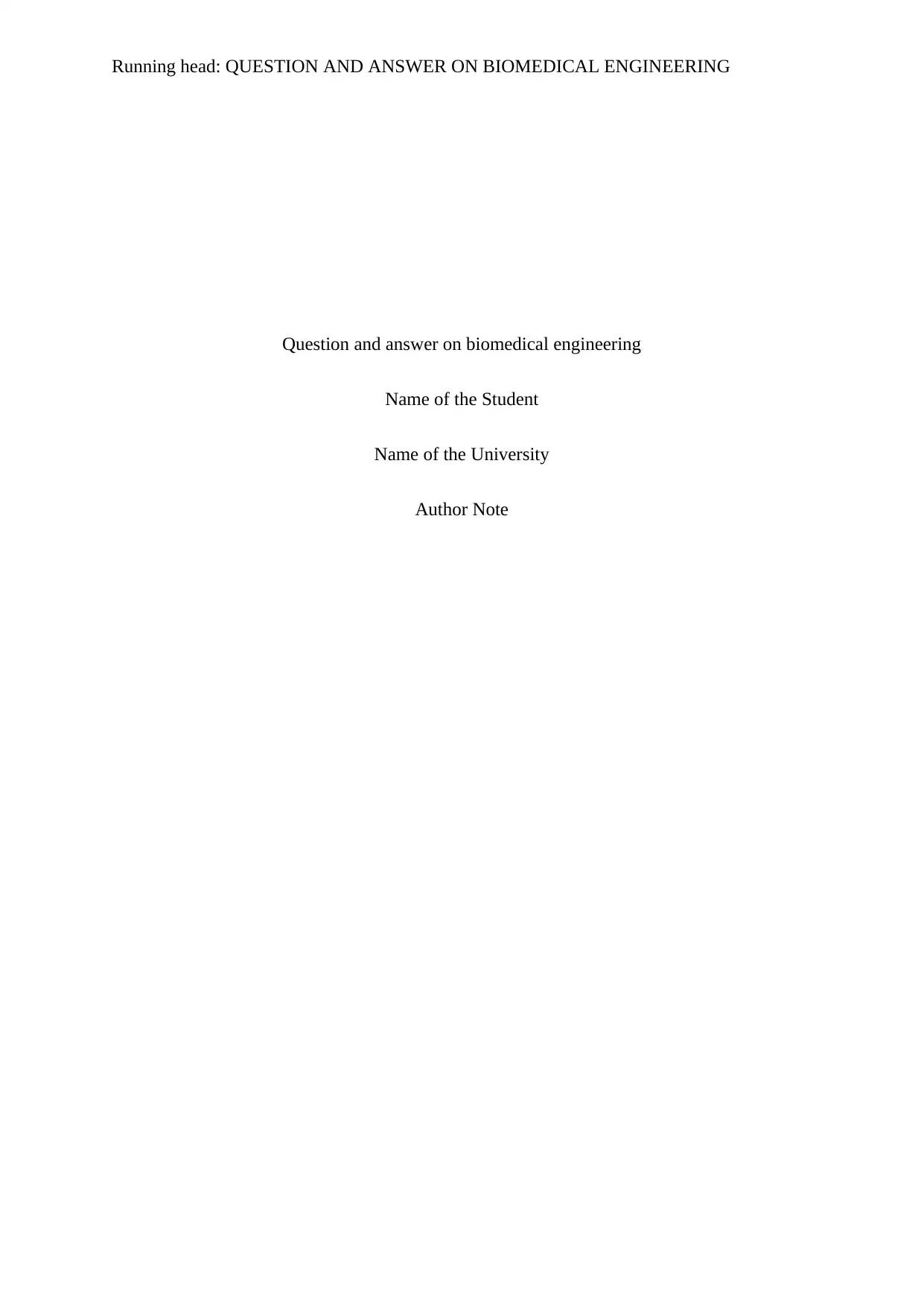
Running head: QUESTION AND ANSWER ON BIOMEDICAL ENGINEERING
Question and answer on biomedical engineering
Name of the Student
Name of the University
Author Note
Question and answer on biomedical engineering
Name of the Student
Name of the University
Author Note
Secure Best Marks with AI Grader
Need help grading? Try our AI Grader for instant feedback on your assignments.
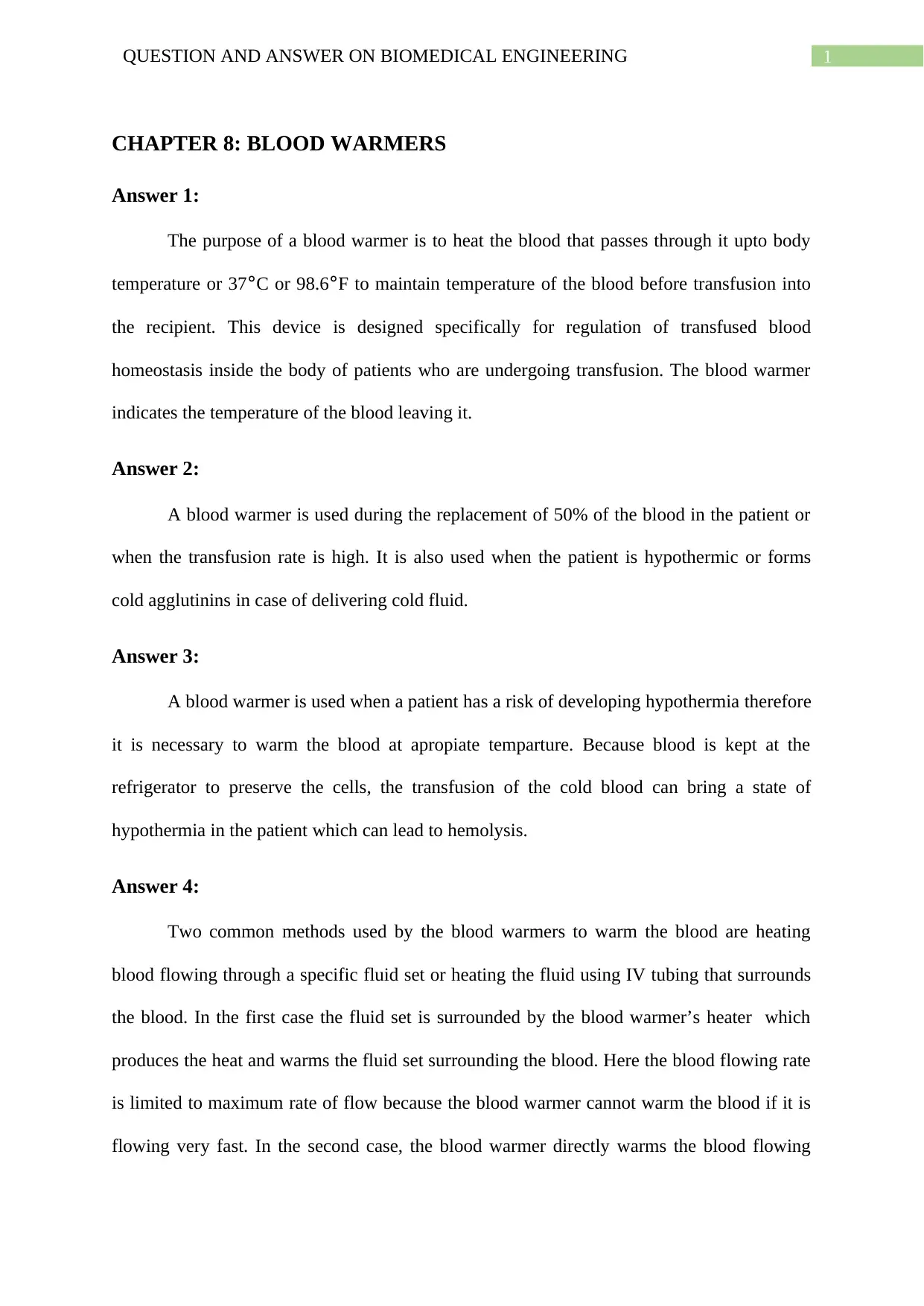
1QUESTION AND ANSWER ON BIOMEDICAL ENGINEERING
CHAPTER 8: BLOOD WARMERS
Answer 1:
The purpose of a blood warmer is to heat the blood that passes through it upto body
temperature or 37°C or 98.6°F to maintain temperature of the blood before transfusion into
the recipient. This device is designed specifically for regulation of transfused blood
homeostasis inside the body of patients who are undergoing transfusion. The blood warmer
indicates the temperature of the blood leaving it.
Answer 2:
A blood warmer is used during the replacement of 50% of the blood in the patient or
when the transfusion rate is high. It is also used when the patient is hypothermic or forms
cold agglutinins in case of delivering cold fluid.
Answer 3:
A blood warmer is used when a patient has a risk of developing hypothermia therefore
it is necessary to warm the blood at apropiate temparture. Because blood is kept at the
refrigerator to preserve the cells, the transfusion of the cold blood can bring a state of
hypothermia in the patient which can lead to hemolysis.
Answer 4:
Two common methods used by the blood warmers to warm the blood are heating
blood flowing through a specific fluid set or heating the fluid using IV tubing that surrounds
the blood. In the first case the fluid set is surrounded by the blood warmer’s heater which
produces the heat and warms the fluid set surrounding the blood. Here the blood flowing rate
is limited to maximum rate of flow because the blood warmer cannot warm the blood if it is
flowing very fast. In the second case, the blood warmer directly warms the blood flowing
CHAPTER 8: BLOOD WARMERS
Answer 1:
The purpose of a blood warmer is to heat the blood that passes through it upto body
temperature or 37°C or 98.6°F to maintain temperature of the blood before transfusion into
the recipient. This device is designed specifically for regulation of transfused blood
homeostasis inside the body of patients who are undergoing transfusion. The blood warmer
indicates the temperature of the blood leaving it.
Answer 2:
A blood warmer is used during the replacement of 50% of the blood in the patient or
when the transfusion rate is high. It is also used when the patient is hypothermic or forms
cold agglutinins in case of delivering cold fluid.
Answer 3:
A blood warmer is used when a patient has a risk of developing hypothermia therefore
it is necessary to warm the blood at apropiate temparture. Because blood is kept at the
refrigerator to preserve the cells, the transfusion of the cold blood can bring a state of
hypothermia in the patient which can lead to hemolysis.
Answer 4:
Two common methods used by the blood warmers to warm the blood are heating
blood flowing through a specific fluid set or heating the fluid using IV tubing that surrounds
the blood. In the first case the fluid set is surrounded by the blood warmer’s heater which
produces the heat and warms the fluid set surrounding the blood. Here the blood flowing rate
is limited to maximum rate of flow because the blood warmer cannot warm the blood if it is
flowing very fast. In the second case, the blood warmer directly warms the blood flowing
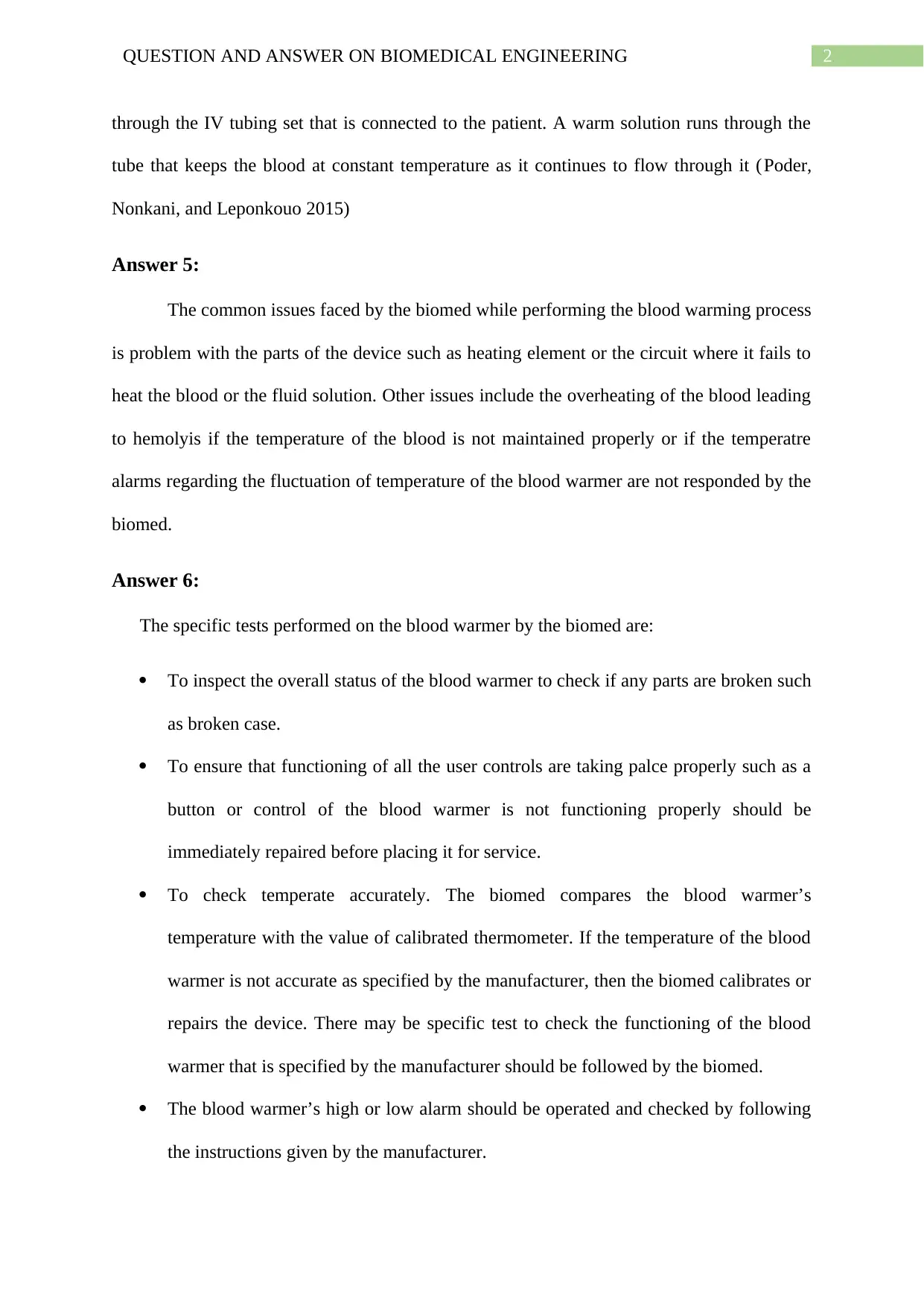
2QUESTION AND ANSWER ON BIOMEDICAL ENGINEERING
through the IV tubing set that is connected to the patient. A warm solution runs through the
tube that keeps the blood at constant temperature as it continues to flow through it (Poder,
Nonkani, and Leponkouo 2015)
Answer 5:
The common issues faced by the biomed while performing the blood warming process
is problem with the parts of the device such as heating element or the circuit where it fails to
heat the blood or the fluid solution. Other issues include the overheating of the blood leading
to hemolyis if the temperature of the blood is not maintained properly or if the temperatre
alarms regarding the fluctuation of temperature of the blood warmer are not responded by the
biomed.
Answer 6:
The specific tests performed on the blood warmer by the biomed are:
To inspect the overall status of the blood warmer to check if any parts are broken such
as broken case.
To ensure that functioning of all the user controls are taking palce properly such as a
button or control of the blood warmer is not functioning properly should be
immediately repaired before placing it for service.
To check temperate accurately. The biomed compares the blood warmer’s
temperature with the value of calibrated thermometer. If the temperature of the blood
warmer is not accurate as specified by the manufacturer, then the biomed calibrates or
repairs the device. There may be specific test to check the functioning of the blood
warmer that is specified by the manufacturer should be followed by the biomed.
The blood warmer’s high or low alarm should be operated and checked by following
the instructions given by the manufacturer.
through the IV tubing set that is connected to the patient. A warm solution runs through the
tube that keeps the blood at constant temperature as it continues to flow through it (Poder,
Nonkani, and Leponkouo 2015)
Answer 5:
The common issues faced by the biomed while performing the blood warming process
is problem with the parts of the device such as heating element or the circuit where it fails to
heat the blood or the fluid solution. Other issues include the overheating of the blood leading
to hemolyis if the temperature of the blood is not maintained properly or if the temperatre
alarms regarding the fluctuation of temperature of the blood warmer are not responded by the
biomed.
Answer 6:
The specific tests performed on the blood warmer by the biomed are:
To inspect the overall status of the blood warmer to check if any parts are broken such
as broken case.
To ensure that functioning of all the user controls are taking palce properly such as a
button or control of the blood warmer is not functioning properly should be
immediately repaired before placing it for service.
To check temperate accurately. The biomed compares the blood warmer’s
temperature with the value of calibrated thermometer. If the temperature of the blood
warmer is not accurate as specified by the manufacturer, then the biomed calibrates or
repairs the device. There may be specific test to check the functioning of the blood
warmer that is specified by the manufacturer should be followed by the biomed.
The blood warmer’s high or low alarm should be operated and checked by following
the instructions given by the manufacturer.
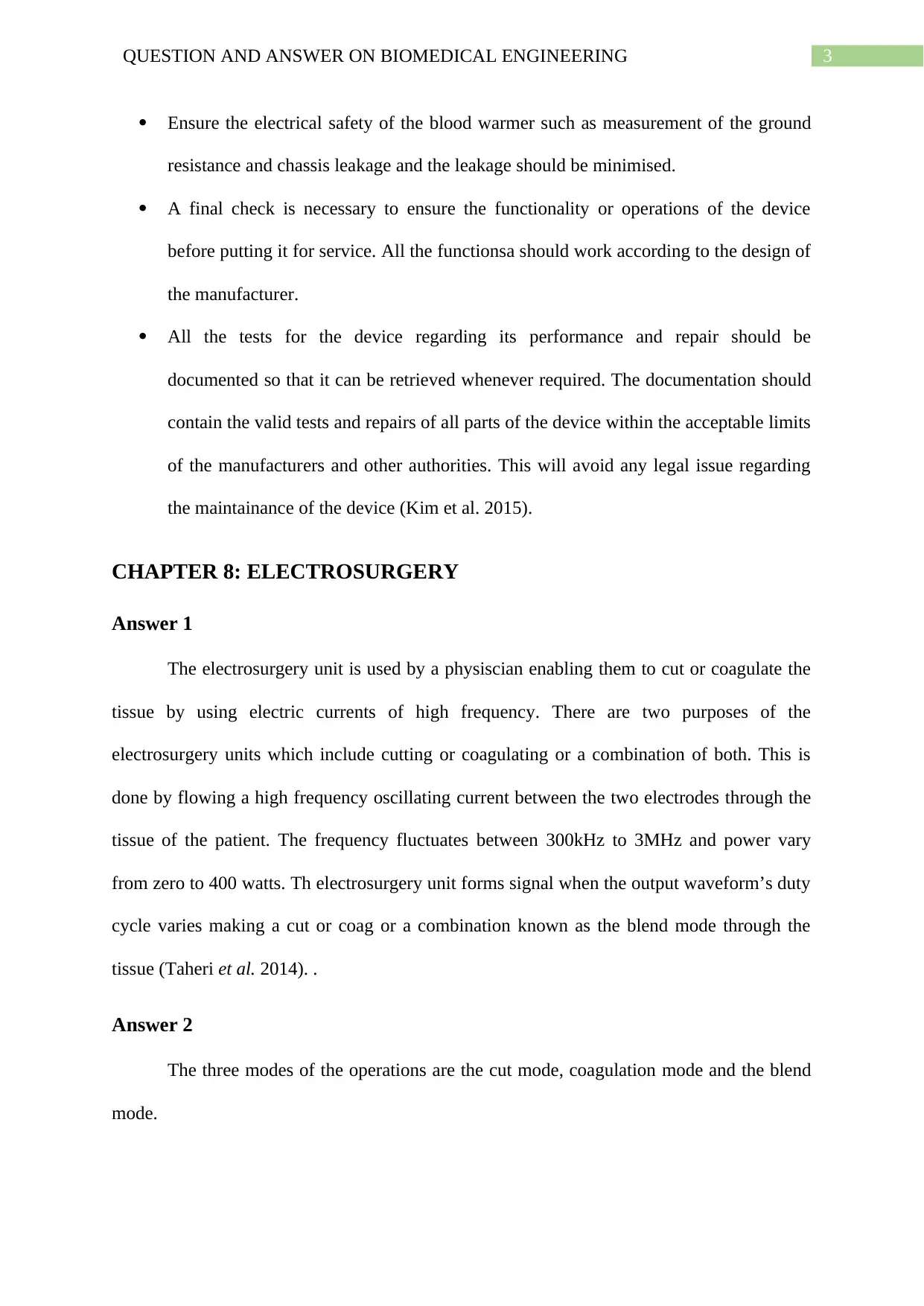
3QUESTION AND ANSWER ON BIOMEDICAL ENGINEERING
Ensure the electrical safety of the blood warmer such as measurement of the ground
resistance and chassis leakage and the leakage should be minimised.
A final check is necessary to ensure the functionality or operations of the device
before putting it for service. All the functionsa should work according to the design of
the manufacturer.
All the tests for the device regarding its performance and repair should be
documented so that it can be retrieved whenever required. The documentation should
contain the valid tests and repairs of all parts of the device within the acceptable limits
of the manufacturers and other authorities. This will avoid any legal issue regarding
the maintainance of the device (Kim et al. 2015).
CHAPTER 8: ELECTROSURGERY
Answer 1
The electrosurgery unit is used by a physiscian enabling them to cut or coagulate the
tissue by using electric currents of high frequency. There are two purposes of the
electrosurgery units which include cutting or coagulating or a combination of both. This is
done by flowing a high frequency oscillating current between the two electrodes through the
tissue of the patient. The frequency fluctuates between 300kHz to 3MHz and power vary
from zero to 400 watts. Th electrosurgery unit forms signal when the output waveform’s duty
cycle varies making a cut or coag or a combination known as the blend mode through the
tissue (Taheri et al. 2014). .
Answer 2
The three modes of the operations are the cut mode, coagulation mode and the blend
mode.
Ensure the electrical safety of the blood warmer such as measurement of the ground
resistance and chassis leakage and the leakage should be minimised.
A final check is necessary to ensure the functionality or operations of the device
before putting it for service. All the functionsa should work according to the design of
the manufacturer.
All the tests for the device regarding its performance and repair should be
documented so that it can be retrieved whenever required. The documentation should
contain the valid tests and repairs of all parts of the device within the acceptable limits
of the manufacturers and other authorities. This will avoid any legal issue regarding
the maintainance of the device (Kim et al. 2015).
CHAPTER 8: ELECTROSURGERY
Answer 1
The electrosurgery unit is used by a physiscian enabling them to cut or coagulate the
tissue by using electric currents of high frequency. There are two purposes of the
electrosurgery units which include cutting or coagulating or a combination of both. This is
done by flowing a high frequency oscillating current between the two electrodes through the
tissue of the patient. The frequency fluctuates between 300kHz to 3MHz and power vary
from zero to 400 watts. Th electrosurgery unit forms signal when the output waveform’s duty
cycle varies making a cut or coag or a combination known as the blend mode through the
tissue (Taheri et al. 2014). .
Answer 2
The three modes of the operations are the cut mode, coagulation mode and the blend
mode.
Secure Best Marks with AI Grader
Need help grading? Try our AI Grader for instant feedback on your assignments.
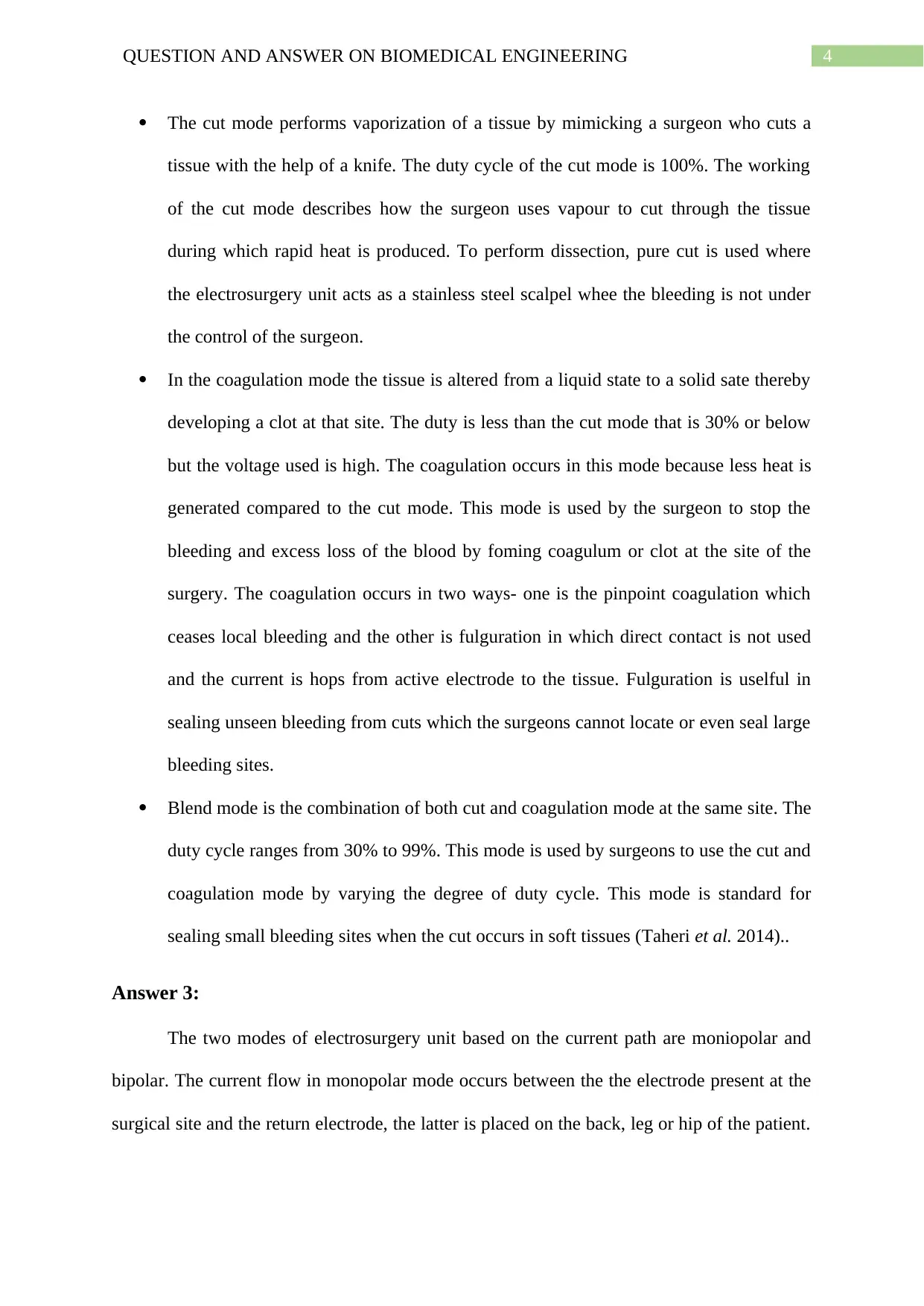
4QUESTION AND ANSWER ON BIOMEDICAL ENGINEERING
The cut mode performs vaporization of a tissue by mimicking a surgeon who cuts a
tissue with the help of a knife. The duty cycle of the cut mode is 100%. The working
of the cut mode describes how the surgeon uses vapour to cut through the tissue
during which rapid heat is produced. To perform dissection, pure cut is used where
the electrosurgery unit acts as a stainless steel scalpel whee the bleeding is not under
the control of the surgeon.
In the coagulation mode the tissue is altered from a liquid state to a solid sate thereby
developing a clot at that site. The duty is less than the cut mode that is 30% or below
but the voltage used is high. The coagulation occurs in this mode because less heat is
generated compared to the cut mode. This mode is used by the surgeon to stop the
bleeding and excess loss of the blood by foming coagulum or clot at the site of the
surgery. The coagulation occurs in two ways- one is the pinpoint coagulation which
ceases local bleeding and the other is fulguration in which direct contact is not used
and the current is hops from active electrode to the tissue. Fulguration is uselful in
sealing unseen bleeding from cuts which the surgeons cannot locate or even seal large
bleeding sites.
Blend mode is the combination of both cut and coagulation mode at the same site. The
duty cycle ranges from 30% to 99%. This mode is used by surgeons to use the cut and
coagulation mode by varying the degree of duty cycle. This mode is standard for
sealing small bleeding sites when the cut occurs in soft tissues (Taheri et al. 2014)..
Answer 3:
The two modes of electrosurgery unit based on the current path are moniopolar and
bipolar. The current flow in monopolar mode occurs between the the electrode present at the
surgical site and the return electrode, the latter is placed on the back, leg or hip of the patient.
The cut mode performs vaporization of a tissue by mimicking a surgeon who cuts a
tissue with the help of a knife. The duty cycle of the cut mode is 100%. The working
of the cut mode describes how the surgeon uses vapour to cut through the tissue
during which rapid heat is produced. To perform dissection, pure cut is used where
the electrosurgery unit acts as a stainless steel scalpel whee the bleeding is not under
the control of the surgeon.
In the coagulation mode the tissue is altered from a liquid state to a solid sate thereby
developing a clot at that site. The duty is less than the cut mode that is 30% or below
but the voltage used is high. The coagulation occurs in this mode because less heat is
generated compared to the cut mode. This mode is used by the surgeon to stop the
bleeding and excess loss of the blood by foming coagulum or clot at the site of the
surgery. The coagulation occurs in two ways- one is the pinpoint coagulation which
ceases local bleeding and the other is fulguration in which direct contact is not used
and the current is hops from active electrode to the tissue. Fulguration is uselful in
sealing unseen bleeding from cuts which the surgeons cannot locate or even seal large
bleeding sites.
Blend mode is the combination of both cut and coagulation mode at the same site. The
duty cycle ranges from 30% to 99%. This mode is used by surgeons to use the cut and
coagulation mode by varying the degree of duty cycle. This mode is standard for
sealing small bleeding sites when the cut occurs in soft tissues (Taheri et al. 2014)..
Answer 3:
The two modes of electrosurgery unit based on the current path are moniopolar and
bipolar. The current flow in monopolar mode occurs between the the electrode present at the
surgical site and the return electrode, the latter is placed on the back, leg or hip of the patient.
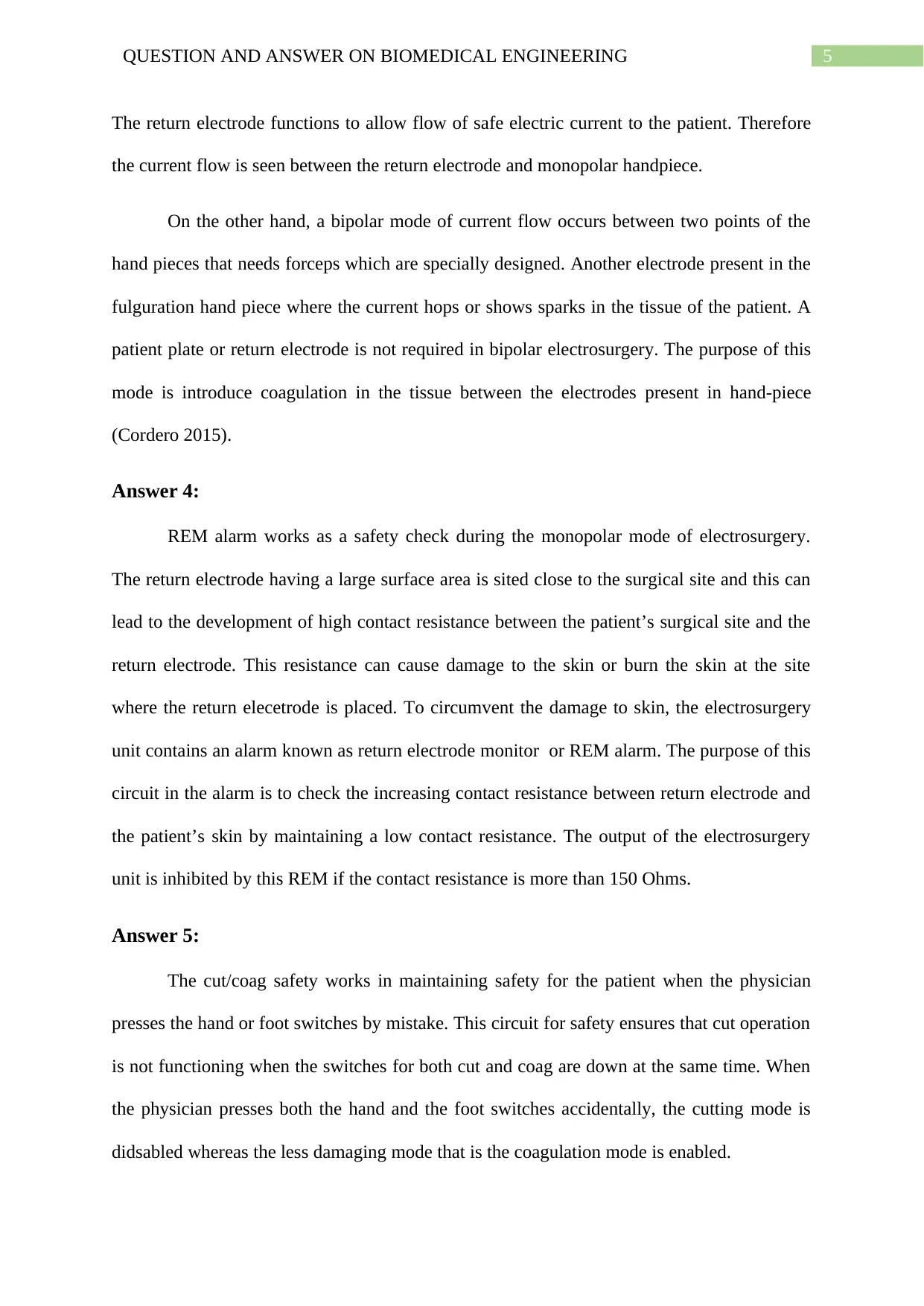
5QUESTION AND ANSWER ON BIOMEDICAL ENGINEERING
The return electrode functions to allow flow of safe electric current to the patient. Therefore
the current flow is seen between the return electrode and monopolar handpiece.
On the other hand, a bipolar mode of current flow occurs between two points of the
hand pieces that needs forceps which are specially designed. Another electrode present in the
fulguration hand piece where the current hops or shows sparks in the tissue of the patient. A
patient plate or return electrode is not required in bipolar electrosurgery. The purpose of this
mode is introduce coagulation in the tissue between the electrodes present in hand-piece
(Cordero 2015).
Answer 4:
REM alarm works as a safety check during the monopolar mode of electrosurgery.
The return electrode having a large surface area is sited close to the surgical site and this can
lead to the development of high contact resistance between the patient’s surgical site and the
return electrode. This resistance can cause damage to the skin or burn the skin at the site
where the return elecetrode is placed. To circumvent the damage to skin, the electrosurgery
unit contains an alarm known as return electrode monitor or REM alarm. The purpose of this
circuit in the alarm is to check the increasing contact resistance between return electrode and
the patient’s skin by maintaining a low contact resistance. The output of the electrosurgery
unit is inhibited by this REM if the contact resistance is more than 150 Ohms.
Answer 5:
The cut/coag safety works in maintaining safety for the patient when the physician
presses the hand or foot switches by mistake. This circuit for safety ensures that cut operation
is not functioning when the switches for both cut and coag are down at the same time. When
the physician presses both the hand and the foot switches accidentally, the cutting mode is
didsabled whereas the less damaging mode that is the coagulation mode is enabled.
The return electrode functions to allow flow of safe electric current to the patient. Therefore
the current flow is seen between the return electrode and monopolar handpiece.
On the other hand, a bipolar mode of current flow occurs between two points of the
hand pieces that needs forceps which are specially designed. Another electrode present in the
fulguration hand piece where the current hops or shows sparks in the tissue of the patient. A
patient plate or return electrode is not required in bipolar electrosurgery. The purpose of this
mode is introduce coagulation in the tissue between the electrodes present in hand-piece
(Cordero 2015).
Answer 4:
REM alarm works as a safety check during the monopolar mode of electrosurgery.
The return electrode having a large surface area is sited close to the surgical site and this can
lead to the development of high contact resistance between the patient’s surgical site and the
return electrode. This resistance can cause damage to the skin or burn the skin at the site
where the return elecetrode is placed. To circumvent the damage to skin, the electrosurgery
unit contains an alarm known as return electrode monitor or REM alarm. The purpose of this
circuit in the alarm is to check the increasing contact resistance between return electrode and
the patient’s skin by maintaining a low contact resistance. The output of the electrosurgery
unit is inhibited by this REM if the contact resistance is more than 150 Ohms.
Answer 5:
The cut/coag safety works in maintaining safety for the patient when the physician
presses the hand or foot switches by mistake. This circuit for safety ensures that cut operation
is not functioning when the switches for both cut and coag are down at the same time. When
the physician presses both the hand and the foot switches accidentally, the cutting mode is
didsabled whereas the less damaging mode that is the coagulation mode is enabled.
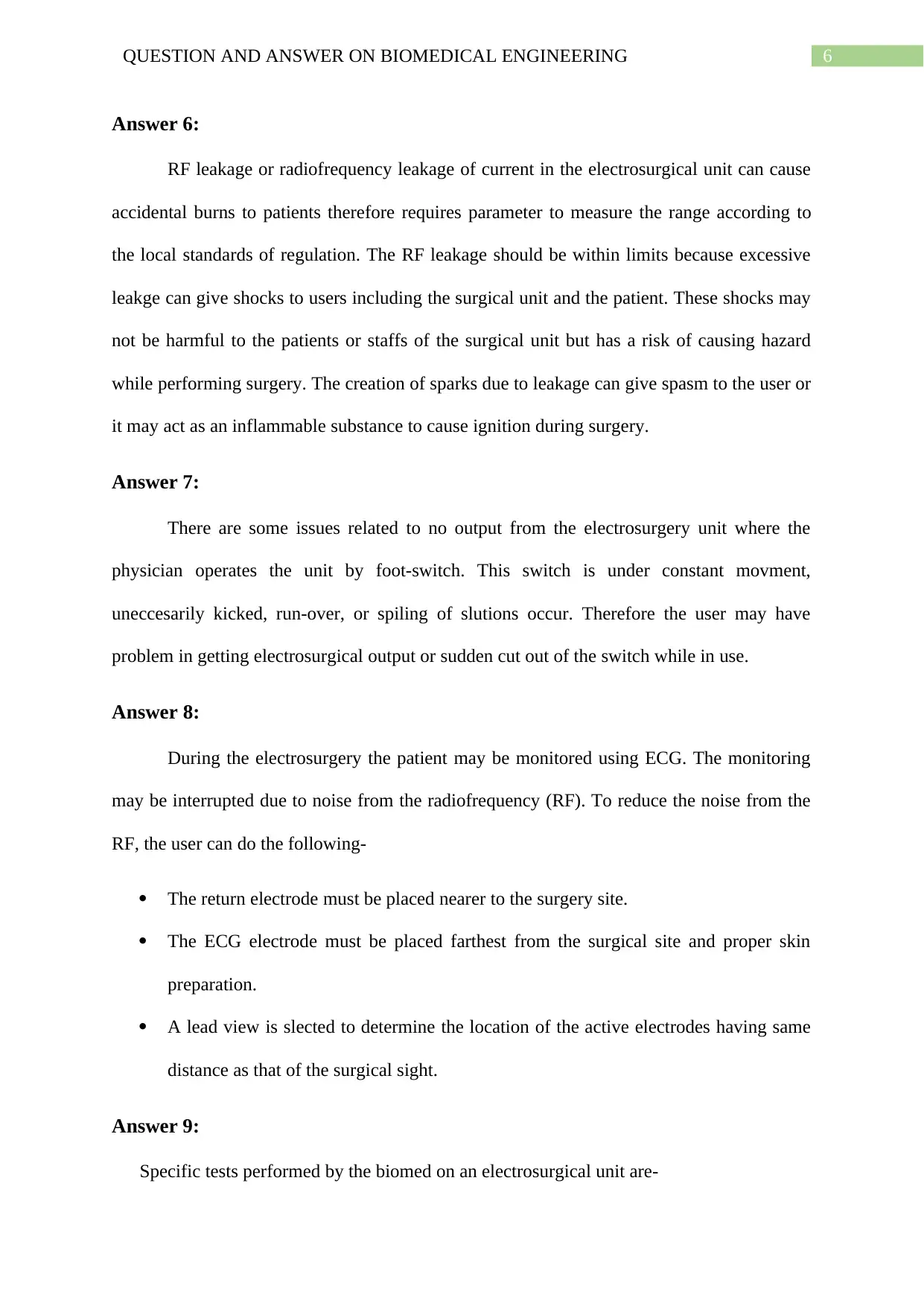
6QUESTION AND ANSWER ON BIOMEDICAL ENGINEERING
Answer 6:
RF leakage or radiofrequency leakage of current in the electrosurgical unit can cause
accidental burns to patients therefore requires parameter to measure the range according to
the local standards of regulation. The RF leakage should be within limits because excessive
leakge can give shocks to users including the surgical unit and the patient. These shocks may
not be harmful to the patients or staffs of the surgical unit but has a risk of causing hazard
while performing surgery. The creation of sparks due to leakage can give spasm to the user or
it may act as an inflammable substance to cause ignition during surgery.
Answer 7:
There are some issues related to no output from the electrosurgery unit where the
physician operates the unit by foot-switch. This switch is under constant movment,
uneccesarily kicked, run-over, or spiling of slutions occur. Therefore the user may have
problem in getting electrosurgical output or sudden cut out of the switch while in use.
Answer 8:
During the electrosurgery the patient may be monitored using ECG. The monitoring
may be interrupted due to noise from the radiofrequency (RF). To reduce the noise from the
RF, the user can do the following-
The return electrode must be placed nearer to the surgery site.
The ECG electrode must be placed farthest from the surgical site and proper skin
preparation.
A lead view is slected to determine the location of the active electrodes having same
distance as that of the surgical sight.
Answer 9:
Specific tests performed by the biomed on an electrosurgical unit are-
Answer 6:
RF leakage or radiofrequency leakage of current in the electrosurgical unit can cause
accidental burns to patients therefore requires parameter to measure the range according to
the local standards of regulation. The RF leakage should be within limits because excessive
leakge can give shocks to users including the surgical unit and the patient. These shocks may
not be harmful to the patients or staffs of the surgical unit but has a risk of causing hazard
while performing surgery. The creation of sparks due to leakage can give spasm to the user or
it may act as an inflammable substance to cause ignition during surgery.
Answer 7:
There are some issues related to no output from the electrosurgery unit where the
physician operates the unit by foot-switch. This switch is under constant movment,
uneccesarily kicked, run-over, or spiling of slutions occur. Therefore the user may have
problem in getting electrosurgical output or sudden cut out of the switch while in use.
Answer 8:
During the electrosurgery the patient may be monitored using ECG. The monitoring
may be interrupted due to noise from the radiofrequency (RF). To reduce the noise from the
RF, the user can do the following-
The return electrode must be placed nearer to the surgery site.
The ECG electrode must be placed farthest from the surgical site and proper skin
preparation.
A lead view is slected to determine the location of the active electrodes having same
distance as that of the surgical sight.
Answer 9:
Specific tests performed by the biomed on an electrosurgical unit are-
Paraphrase This Document
Need a fresh take? Get an instant paraphrase of this document with our AI Paraphraser
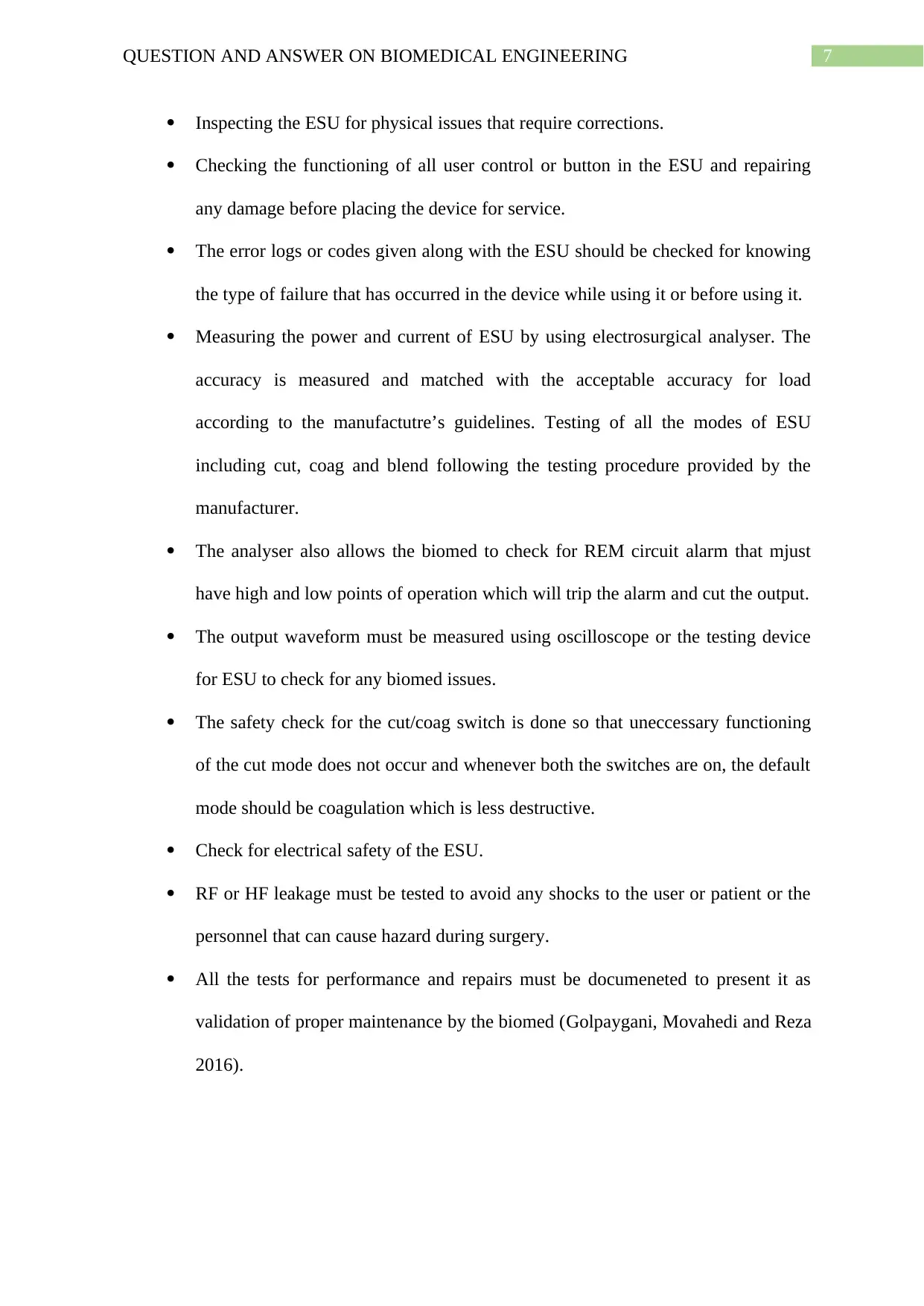
7QUESTION AND ANSWER ON BIOMEDICAL ENGINEERING
Inspecting the ESU for physical issues that require corrections.
Checking the functioning of all user control or button in the ESU and repairing
any damage before placing the device for service.
The error logs or codes given along with the ESU should be checked for knowing
the type of failure that has occurred in the device while using it or before using it.
Measuring the power and current of ESU by using electrosurgical analyser. The
accuracy is measured and matched with the acceptable accuracy for load
according to the manufactutre’s guidelines. Testing of all the modes of ESU
including cut, coag and blend following the testing procedure provided by the
manufacturer.
The analyser also allows the biomed to check for REM circuit alarm that mjust
have high and low points of operation which will trip the alarm and cut the output.
The output waveform must be measured using oscilloscope or the testing device
for ESU to check for any biomed issues.
The safety check for the cut/coag switch is done so that uneccessary functioning
of the cut mode does not occur and whenever both the switches are on, the default
mode should be coagulation which is less destructive.
Check for electrical safety of the ESU.
RF or HF leakage must be tested to avoid any shocks to the user or patient or the
personnel that can cause hazard during surgery.
All the tests for performance and repairs must be documeneted to present it as
validation of proper maintenance by the biomed (Golpaygani, Movahedi and Reza
2016).
Inspecting the ESU for physical issues that require corrections.
Checking the functioning of all user control or button in the ESU and repairing
any damage before placing the device for service.
The error logs or codes given along with the ESU should be checked for knowing
the type of failure that has occurred in the device while using it or before using it.
Measuring the power and current of ESU by using electrosurgical analyser. The
accuracy is measured and matched with the acceptable accuracy for load
according to the manufactutre’s guidelines. Testing of all the modes of ESU
including cut, coag and blend following the testing procedure provided by the
manufacturer.
The analyser also allows the biomed to check for REM circuit alarm that mjust
have high and low points of operation which will trip the alarm and cut the output.
The output waveform must be measured using oscilloscope or the testing device
for ESU to check for any biomed issues.
The safety check for the cut/coag switch is done so that uneccessary functioning
of the cut mode does not occur and whenever both the switches are on, the default
mode should be coagulation which is less destructive.
Check for electrical safety of the ESU.
RF or HF leakage must be tested to avoid any shocks to the user or patient or the
personnel that can cause hazard during surgery.
All the tests for performance and repairs must be documeneted to present it as
validation of proper maintenance by the biomed (Golpaygani, Movahedi and Reza
2016).
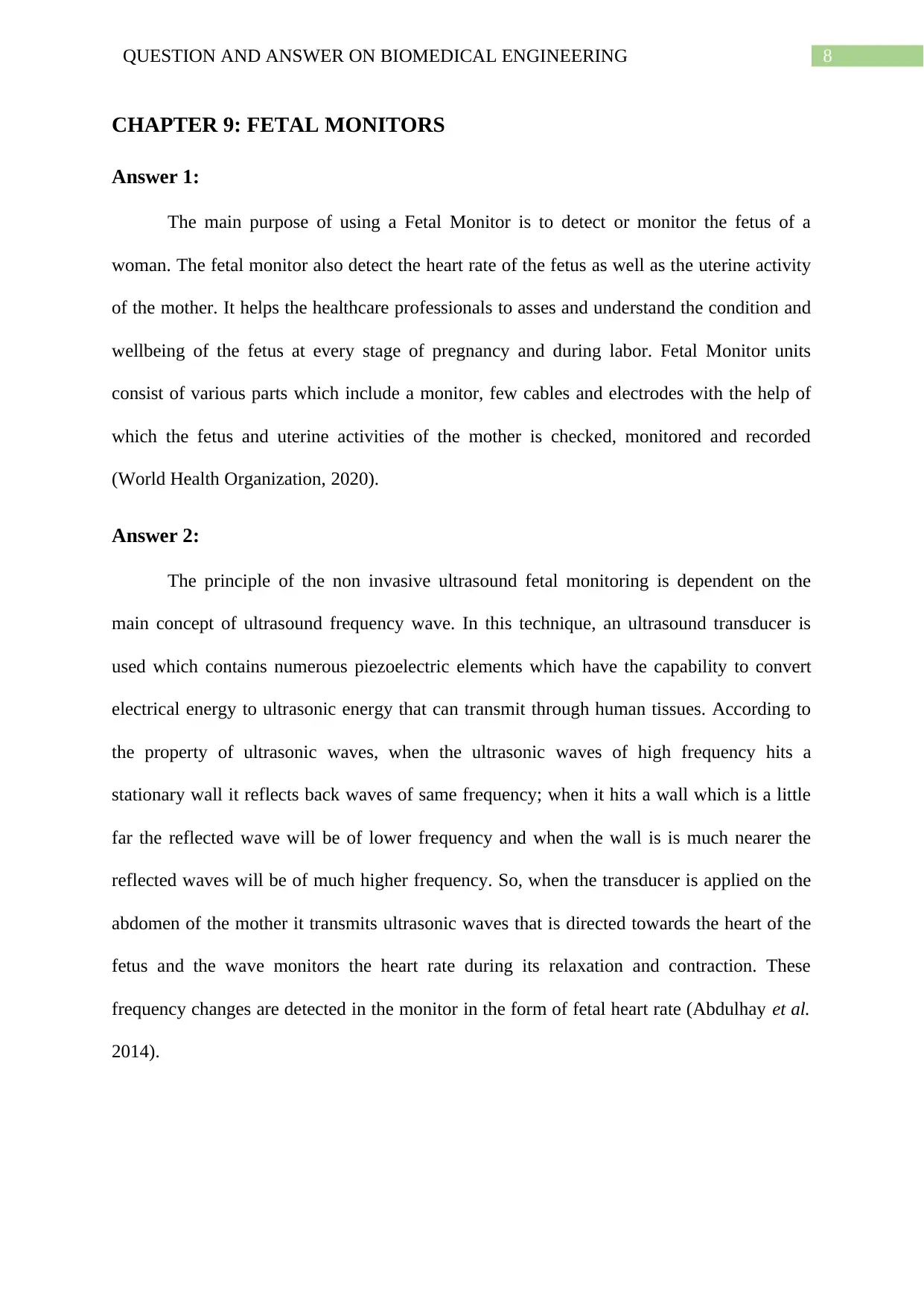
8QUESTION AND ANSWER ON BIOMEDICAL ENGINEERING
CHAPTER 9: FETAL MONITORS
Answer 1:
The main purpose of using a Fetal Monitor is to detect or monitor the fetus of a
woman. The fetal monitor also detect the heart rate of the fetus as well as the uterine activity
of the mother. It helps the healthcare professionals to asses and understand the condition and
wellbeing of the fetus at every stage of pregnancy and during labor. Fetal Monitor units
consist of various parts which include a monitor, few cables and electrodes with the help of
which the fetus and uterine activities of the mother is checked, monitored and recorded
(World Health Organization, 2020).
Answer 2:
The principle of the non invasive ultrasound fetal monitoring is dependent on the
main concept of ultrasound frequency wave. In this technique, an ultrasound transducer is
used which contains numerous piezoelectric elements which have the capability to convert
electrical energy to ultrasonic energy that can transmit through human tissues. According to
the property of ultrasonic waves, when the ultrasonic waves of high frequency hits a
stationary wall it reflects back waves of same frequency; when it hits a wall which is a little
far the reflected wave will be of lower frequency and when the wall is is much nearer the
reflected waves will be of much higher frequency. So, when the transducer is applied on the
abdomen of the mother it transmits ultrasonic waves that is directed towards the heart of the
fetus and the wave monitors the heart rate during its relaxation and contraction. These
frequency changes are detected in the monitor in the form of fetal heart rate (Abdulhay et al.
2014).
CHAPTER 9: FETAL MONITORS
Answer 1:
The main purpose of using a Fetal Monitor is to detect or monitor the fetus of a
woman. The fetal monitor also detect the heart rate of the fetus as well as the uterine activity
of the mother. It helps the healthcare professionals to asses and understand the condition and
wellbeing of the fetus at every stage of pregnancy and during labor. Fetal Monitor units
consist of various parts which include a monitor, few cables and electrodes with the help of
which the fetus and uterine activities of the mother is checked, monitored and recorded
(World Health Organization, 2020).
Answer 2:
The principle of the non invasive ultrasound fetal monitoring is dependent on the
main concept of ultrasound frequency wave. In this technique, an ultrasound transducer is
used which contains numerous piezoelectric elements which have the capability to convert
electrical energy to ultrasonic energy that can transmit through human tissues. According to
the property of ultrasonic waves, when the ultrasonic waves of high frequency hits a
stationary wall it reflects back waves of same frequency; when it hits a wall which is a little
far the reflected wave will be of lower frequency and when the wall is is much nearer the
reflected waves will be of much higher frequency. So, when the transducer is applied on the
abdomen of the mother it transmits ultrasonic waves that is directed towards the heart of the
fetus and the wave monitors the heart rate during its relaxation and contraction. These
frequency changes are detected in the monitor in the form of fetal heart rate (Abdulhay et al.
2014).
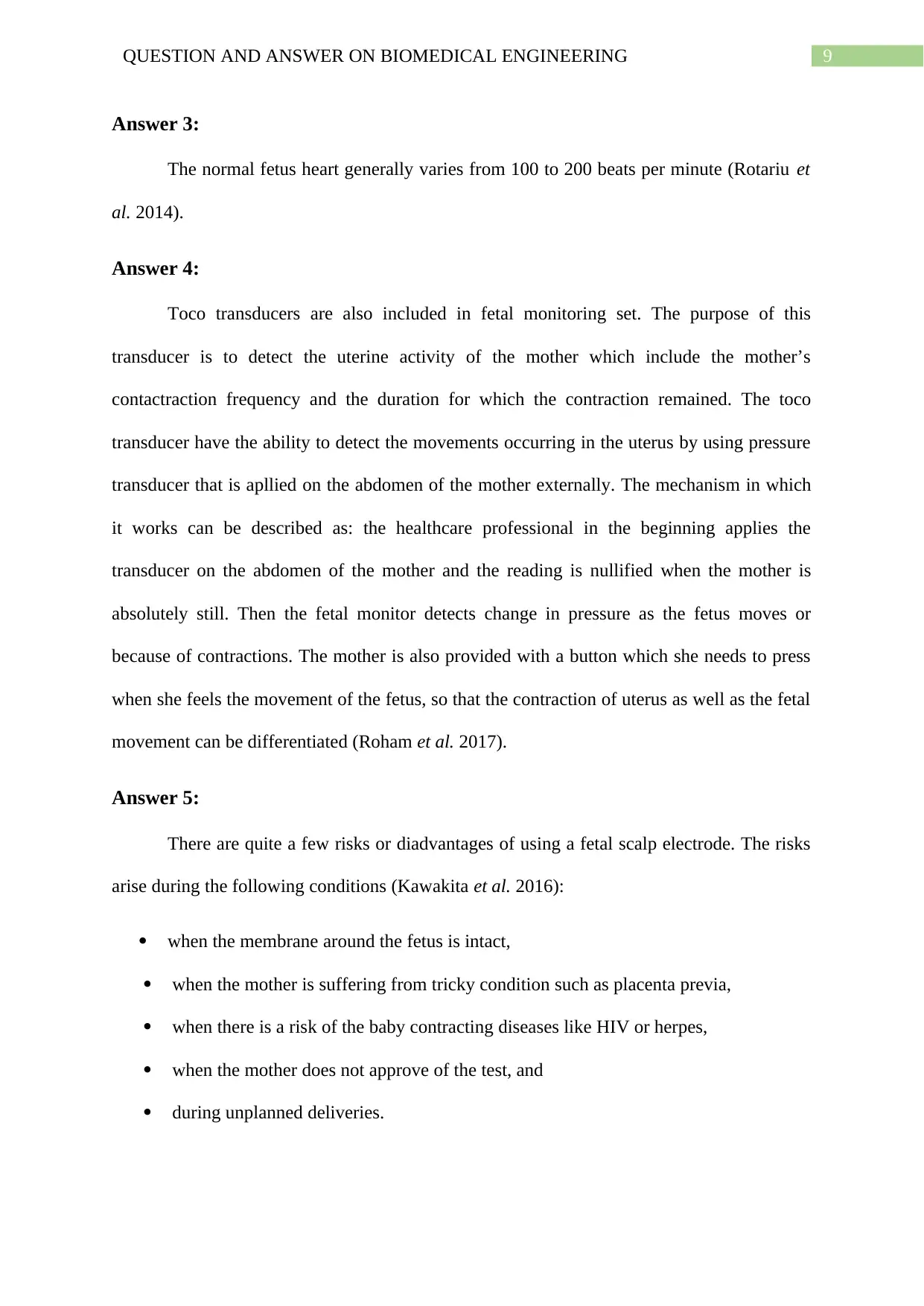
9QUESTION AND ANSWER ON BIOMEDICAL ENGINEERING
Answer 3:
The normal fetus heart generally varies from 100 to 200 beats per minute (Rotariu et
al. 2014).
Answer 4:
Toco transducers are also included in fetal monitoring set. The purpose of this
transducer is to detect the uterine activity of the mother which include the mother’s
contactraction frequency and the duration for which the contraction remained. The toco
transducer have the ability to detect the movements occurring in the uterus by using pressure
transducer that is apllied on the abdomen of the mother externally. The mechanism in which
it works can be described as: the healthcare professional in the beginning applies the
transducer on the abdomen of the mother and the reading is nullified when the mother is
absolutely still. Then the fetal monitor detects change in pressure as the fetus moves or
because of contractions. The mother is also provided with a button which she needs to press
when she feels the movement of the fetus, so that the contraction of uterus as well as the fetal
movement can be differentiated (Roham et al. 2017).
Answer 5:
There are quite a few risks or diadvantages of using a fetal scalp electrode. The risks
arise during the following conditions (Kawakita et al. 2016):
when the membrane around the fetus is intact,
when the mother is suffering from tricky condition such as placenta previa,
when there is a risk of the baby contracting diseases like HIV or herpes,
when the mother does not approve of the test, and
during unplanned deliveries.
Answer 3:
The normal fetus heart generally varies from 100 to 200 beats per minute (Rotariu et
al. 2014).
Answer 4:
Toco transducers are also included in fetal monitoring set. The purpose of this
transducer is to detect the uterine activity of the mother which include the mother’s
contactraction frequency and the duration for which the contraction remained. The toco
transducer have the ability to detect the movements occurring in the uterus by using pressure
transducer that is apllied on the abdomen of the mother externally. The mechanism in which
it works can be described as: the healthcare professional in the beginning applies the
transducer on the abdomen of the mother and the reading is nullified when the mother is
absolutely still. Then the fetal monitor detects change in pressure as the fetus moves or
because of contractions. The mother is also provided with a button which she needs to press
when she feels the movement of the fetus, so that the contraction of uterus as well as the fetal
movement can be differentiated (Roham et al. 2017).
Answer 5:
There are quite a few risks or diadvantages of using a fetal scalp electrode. The risks
arise during the following conditions (Kawakita et al. 2016):
when the membrane around the fetus is intact,
when the mother is suffering from tricky condition such as placenta previa,
when there is a risk of the baby contracting diseases like HIV or herpes,
when the mother does not approve of the test, and
during unplanned deliveries.
Secure Best Marks with AI Grader
Need help grading? Try our AI Grader for instant feedback on your assignments.

10QUESTION AND ANSWER ON BIOMEDICAL ENGINEERING
The risks which are associated with the use of Intrauterine Pressure Catheter are as
follows (Zaiken et al. 2014):
results in maternal fever, which might lead to the non availability of breast milk to the
child after birth,
results in heavy blood flow in few cases, and
fetal distress which might lead to the death of the fetus.
Answer 6:
There are quite a few tests which are needed to be performed on fetal monitor sets
before using it which include (Neilson and James 2015).
checking all the equipments for any break down and checking the parameter probe as
well,
checking and recognizing any issues in the controlling of the set before using it on a
pregnant lady,
checking and correcting the date and time so that treatment can proceed in the right
direction,
reviewing the error logs the system will gather before operating it,
the ultrasound transducer should be tested for ensuring proper functioning,
ensuring the toco transducer’s proper functioning,
checking the heart rate detector of invasisve fetal scalp electrode before using it,
checking and ensuring the appropriate accuracy of pressure of intrauterine pressure
catheter,
checking the accuracy of SpO2 saturation, and
ensuring the ECG accuracy.
The risks which are associated with the use of Intrauterine Pressure Catheter are as
follows (Zaiken et al. 2014):
results in maternal fever, which might lead to the non availability of breast milk to the
child after birth,
results in heavy blood flow in few cases, and
fetal distress which might lead to the death of the fetus.
Answer 6:
There are quite a few tests which are needed to be performed on fetal monitor sets
before using it which include (Neilson and James 2015).
checking all the equipments for any break down and checking the parameter probe as
well,
checking and recognizing any issues in the controlling of the set before using it on a
pregnant lady,
checking and correcting the date and time so that treatment can proceed in the right
direction,
reviewing the error logs the system will gather before operating it,
the ultrasound transducer should be tested for ensuring proper functioning,
ensuring the toco transducer’s proper functioning,
checking the heart rate detector of invasisve fetal scalp electrode before using it,
checking and ensuring the appropriate accuracy of pressure of intrauterine pressure
catheter,
checking the accuracy of SpO2 saturation, and
ensuring the ECG accuracy.
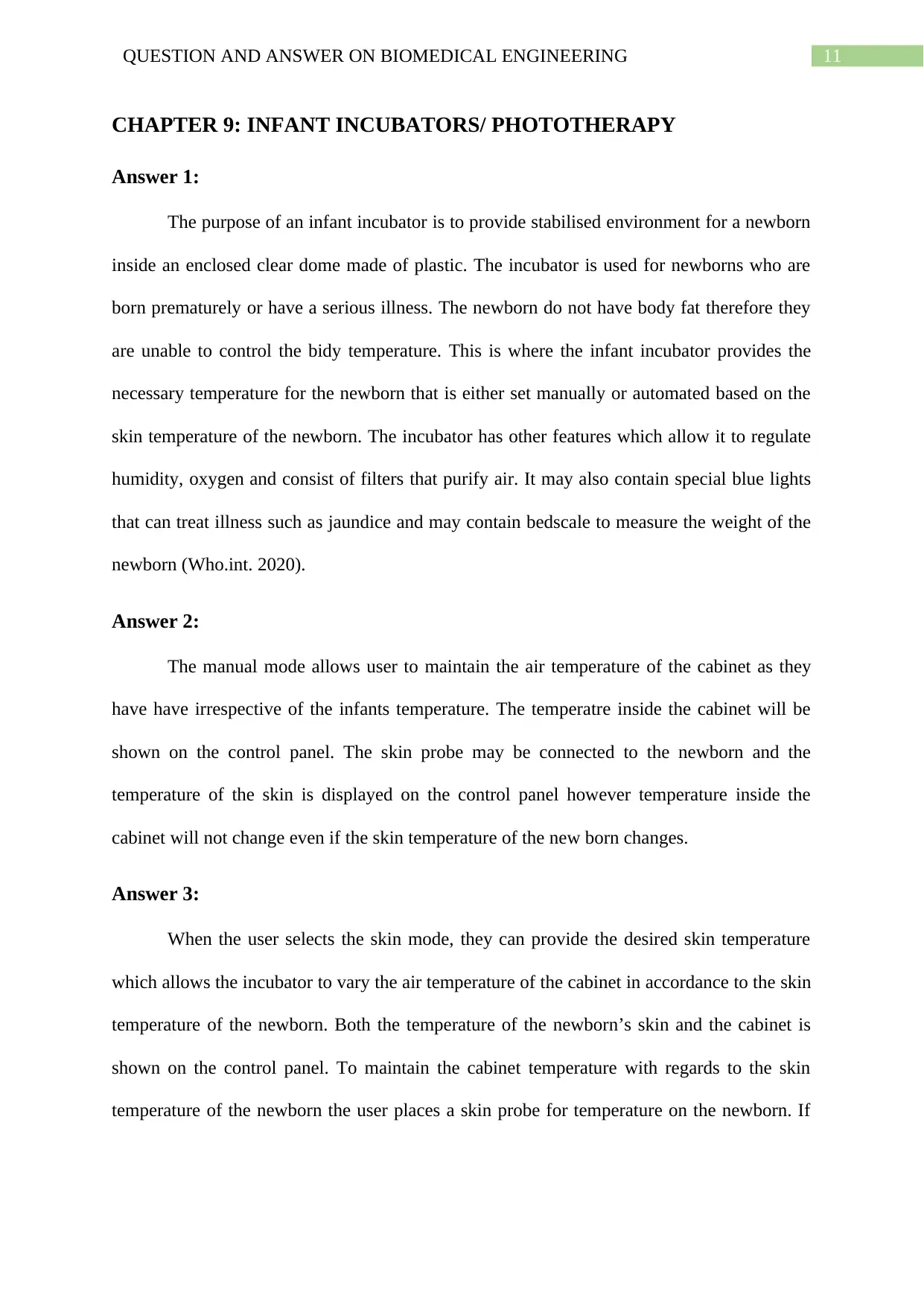
11QUESTION AND ANSWER ON BIOMEDICAL ENGINEERING
CHAPTER 9: INFANT INCUBATORS/ PHOTOTHERAPY
Answer 1:
The purpose of an infant incubator is to provide stabilised environment for a newborn
inside an enclosed clear dome made of plastic. The incubator is used for newborns who are
born prematurely or have a serious illness. The newborn do not have body fat therefore they
are unable to control the bidy temperature. This is where the infant incubator provides the
necessary temperature for the newborn that is either set manually or automated based on the
skin temperature of the newborn. The incubator has other features which allow it to regulate
humidity, oxygen and consist of filters that purify air. It may also contain special blue lights
that can treat illness such as jaundice and may contain bedscale to measure the weight of the
newborn (Who.int. 2020).
Answer 2:
The manual mode allows user to maintain the air temperature of the cabinet as they
have have irrespective of the infants temperature. The temperatre inside the cabinet will be
shown on the control panel. The skin probe may be connected to the newborn and the
temperature of the skin is displayed on the control panel however temperature inside the
cabinet will not change even if the skin temperature of the new born changes.
Answer 3:
When the user selects the skin mode, they can provide the desired skin temperature
which allows the incubator to vary the air temperature of the cabinet in accordance to the skin
temperature of the newborn. Both the temperature of the newborn’s skin and the cabinet is
shown on the control panel. To maintain the cabinet temperature with regards to the skin
temperature of the newborn the user places a skin probe for temperature on the newborn. If
CHAPTER 9: INFANT INCUBATORS/ PHOTOTHERAPY
Answer 1:
The purpose of an infant incubator is to provide stabilised environment for a newborn
inside an enclosed clear dome made of plastic. The incubator is used for newborns who are
born prematurely or have a serious illness. The newborn do not have body fat therefore they
are unable to control the bidy temperature. This is where the infant incubator provides the
necessary temperature for the newborn that is either set manually or automated based on the
skin temperature of the newborn. The incubator has other features which allow it to regulate
humidity, oxygen and consist of filters that purify air. It may also contain special blue lights
that can treat illness such as jaundice and may contain bedscale to measure the weight of the
newborn (Who.int. 2020).
Answer 2:
The manual mode allows user to maintain the air temperature of the cabinet as they
have have irrespective of the infants temperature. The temperatre inside the cabinet will be
shown on the control panel. The skin probe may be connected to the newborn and the
temperature of the skin is displayed on the control panel however temperature inside the
cabinet will not change even if the skin temperature of the new born changes.
Answer 3:
When the user selects the skin mode, they can provide the desired skin temperature
which allows the incubator to vary the air temperature of the cabinet in accordance to the skin
temperature of the newborn. Both the temperature of the newborn’s skin and the cabinet is
shown on the control panel. To maintain the cabinet temperature with regards to the skin
temperature of the newborn the user places a skin probe for temperature on the newborn. If
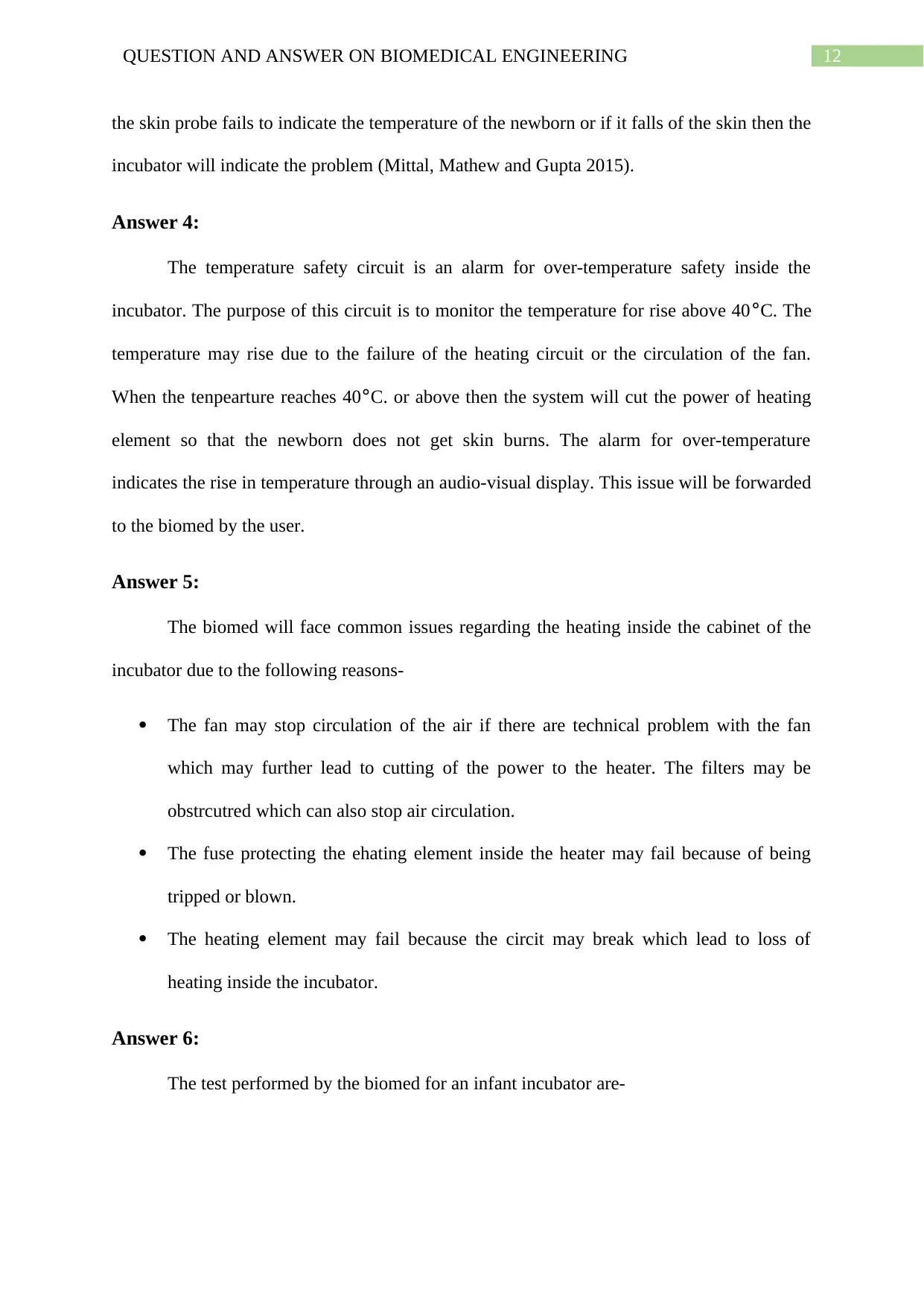
12QUESTION AND ANSWER ON BIOMEDICAL ENGINEERING
the skin probe fails to indicate the temperature of the newborn or if it falls of the skin then the
incubator will indicate the problem (Mittal, Mathew and Gupta 2015).
Answer 4:
The temperature safety circuit is an alarm for over-temperature safety inside the
incubator. The purpose of this circuit is to monitor the temperature for rise above 40°C. The
temperature may rise due to the failure of the heating circuit or the circulation of the fan.
When the tenpearture reaches 40°C. or above then the system will cut the power of heating
element so that the newborn does not get skin burns. The alarm for over-temperature
indicates the rise in temperature through an audio-visual display. This issue will be forwarded
to the biomed by the user.
Answer 5:
The biomed will face common issues regarding the heating inside the cabinet of the
incubator due to the following reasons-
The fan may stop circulation of the air if there are technical problem with the fan
which may further lead to cutting of the power to the heater. The filters may be
obstrcutred which can also stop air circulation.
The fuse protecting the ehating element inside the heater may fail because of being
tripped or blown.
The heating element may fail because the circit may break which lead to loss of
heating inside the incubator.
Answer 6:
The test performed by the biomed for an infant incubator are-
the skin probe fails to indicate the temperature of the newborn or if it falls of the skin then the
incubator will indicate the problem (Mittal, Mathew and Gupta 2015).
Answer 4:
The temperature safety circuit is an alarm for over-temperature safety inside the
incubator. The purpose of this circuit is to monitor the temperature for rise above 40°C. The
temperature may rise due to the failure of the heating circuit or the circulation of the fan.
When the tenpearture reaches 40°C. or above then the system will cut the power of heating
element so that the newborn does not get skin burns. The alarm for over-temperature
indicates the rise in temperature through an audio-visual display. This issue will be forwarded
to the biomed by the user.
Answer 5:
The biomed will face common issues regarding the heating inside the cabinet of the
incubator due to the following reasons-
The fan may stop circulation of the air if there are technical problem with the fan
which may further lead to cutting of the power to the heater. The filters may be
obstrcutred which can also stop air circulation.
The fuse protecting the ehating element inside the heater may fail because of being
tripped or blown.
The heating element may fail because the circit may break which lead to loss of
heating inside the incubator.
Answer 6:
The test performed by the biomed for an infant incubator are-
Paraphrase This Document
Need a fresh take? Get an instant paraphrase of this document with our AI Paraphraser
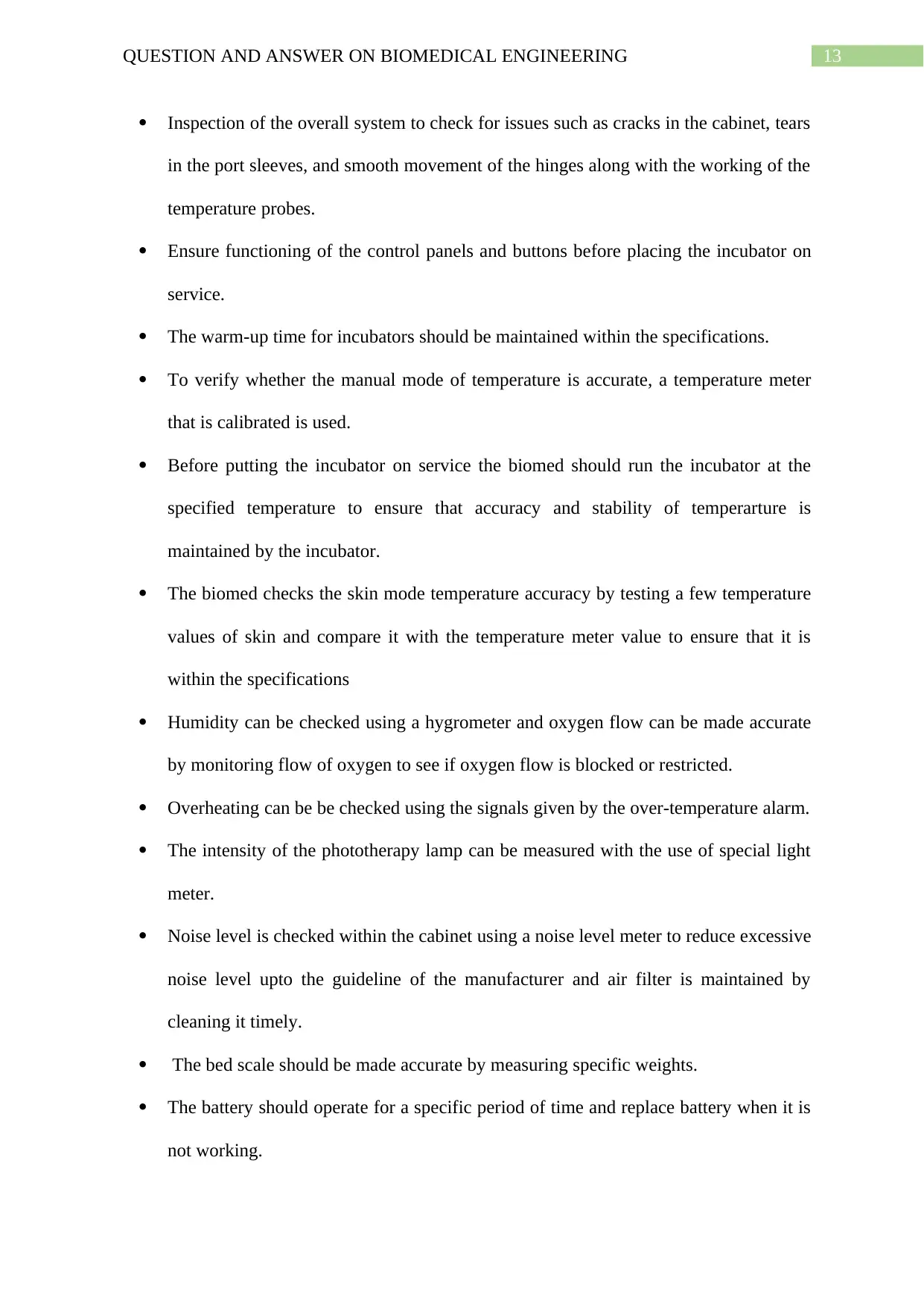
13QUESTION AND ANSWER ON BIOMEDICAL ENGINEERING
Inspection of the overall system to check for issues such as cracks in the cabinet, tears
in the port sleeves, and smooth movement of the hinges along with the working of the
temperature probes.
Ensure functioning of the control panels and buttons before placing the incubator on
service.
The warm-up time for incubators should be maintained within the specifications.
To verify whether the manual mode of temperature is accurate, a temperature meter
that is calibrated is used.
Before putting the incubator on service the biomed should run the incubator at the
specified temperature to ensure that accuracy and stability of temperarture is
maintained by the incubator.
The biomed checks the skin mode temperature accuracy by testing a few temperature
values of skin and compare it with the temperature meter value to ensure that it is
within the specifications
Humidity can be checked using a hygrometer and oxygen flow can be made accurate
by monitoring flow of oxygen to see if oxygen flow is blocked or restricted.
Overheating can be be checked using the signals given by the over-temperature alarm.
The intensity of the phototherapy lamp can be measured with the use of special light
meter.
Noise level is checked within the cabinet using a noise level meter to reduce excessive
noise level upto the guideline of the manufacturer and air filter is maintained by
cleaning it timely.
The bed scale should be made accurate by measuring specific weights.
The battery should operate for a specific period of time and replace battery when it is
not working.
Inspection of the overall system to check for issues such as cracks in the cabinet, tears
in the port sleeves, and smooth movement of the hinges along with the working of the
temperature probes.
Ensure functioning of the control panels and buttons before placing the incubator on
service.
The warm-up time for incubators should be maintained within the specifications.
To verify whether the manual mode of temperature is accurate, a temperature meter
that is calibrated is used.
Before putting the incubator on service the biomed should run the incubator at the
specified temperature to ensure that accuracy and stability of temperarture is
maintained by the incubator.
The biomed checks the skin mode temperature accuracy by testing a few temperature
values of skin and compare it with the temperature meter value to ensure that it is
within the specifications
Humidity can be checked using a hygrometer and oxygen flow can be made accurate
by monitoring flow of oxygen to see if oxygen flow is blocked or restricted.
Overheating can be be checked using the signals given by the over-temperature alarm.
The intensity of the phototherapy lamp can be measured with the use of special light
meter.
Noise level is checked within the cabinet using a noise level meter to reduce excessive
noise level upto the guideline of the manufacturer and air filter is maintained by
cleaning it timely.
The bed scale should be made accurate by measuring specific weights.
The battery should operate for a specific period of time and replace battery when it is
not working.
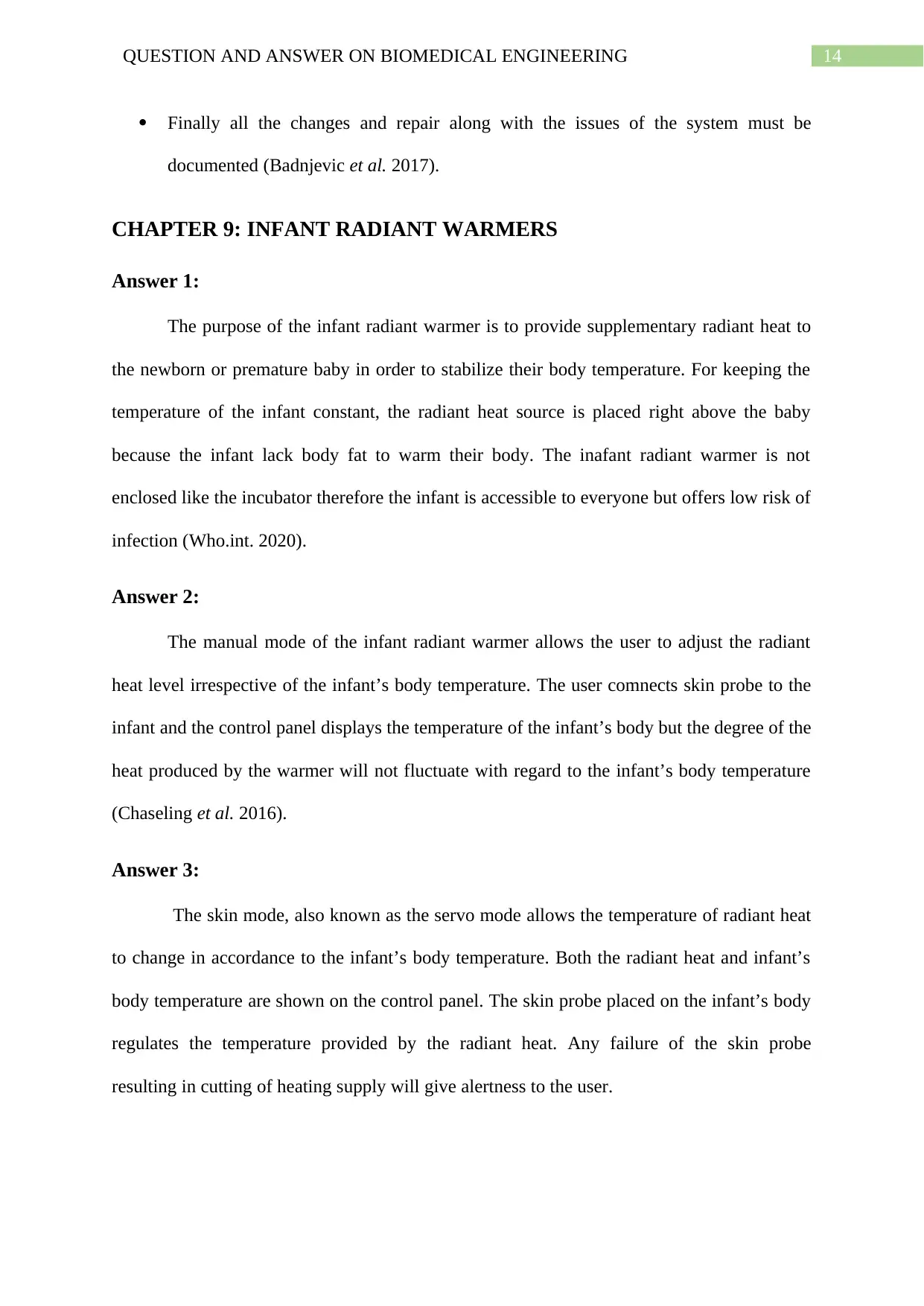
14QUESTION AND ANSWER ON BIOMEDICAL ENGINEERING
Finally all the changes and repair along with the issues of the system must be
documented (Badnjevic et al. 2017).
CHAPTER 9: INFANT RADIANT WARMERS
Answer 1:
The purpose of the infant radiant warmer is to provide supplementary radiant heat to
the newborn or premature baby in order to stabilize their body temperature. For keeping the
temperature of the infant constant, the radiant heat source is placed right above the baby
because the infant lack body fat to warm their body. The inafant radiant warmer is not
enclosed like the incubator therefore the infant is accessible to everyone but offers low risk of
infection (Who.int. 2020).
Answer 2:
The manual mode of the infant radiant warmer allows the user to adjust the radiant
heat level irrespective of the infant’s body temperature. The user comnects skin probe to the
infant and the control panel displays the temperature of the infant’s body but the degree of the
heat produced by the warmer will not fluctuate with regard to the infant’s body temperature
(Chaseling et al. 2016).
Answer 3:
The skin mode, also known as the servo mode allows the temperature of radiant heat
to change in accordance to the infant’s body temperature. Both the radiant heat and infant’s
body temperature are shown on the control panel. The skin probe placed on the infant’s body
regulates the temperature provided by the radiant heat. Any failure of the skin probe
resulting in cutting of heating supply will give alertness to the user.
Finally all the changes and repair along with the issues of the system must be
documented (Badnjevic et al. 2017).
CHAPTER 9: INFANT RADIANT WARMERS
Answer 1:
The purpose of the infant radiant warmer is to provide supplementary radiant heat to
the newborn or premature baby in order to stabilize their body temperature. For keeping the
temperature of the infant constant, the radiant heat source is placed right above the baby
because the infant lack body fat to warm their body. The inafant radiant warmer is not
enclosed like the incubator therefore the infant is accessible to everyone but offers low risk of
infection (Who.int. 2020).
Answer 2:
The manual mode of the infant radiant warmer allows the user to adjust the radiant
heat level irrespective of the infant’s body temperature. The user comnects skin probe to the
infant and the control panel displays the temperature of the infant’s body but the degree of the
heat produced by the warmer will not fluctuate with regard to the infant’s body temperature
(Chaseling et al. 2016).
Answer 3:
The skin mode, also known as the servo mode allows the temperature of radiant heat
to change in accordance to the infant’s body temperature. Both the radiant heat and infant’s
body temperature are shown on the control panel. The skin probe placed on the infant’s body
regulates the temperature provided by the radiant heat. Any failure of the skin probe
resulting in cutting of heating supply will give alertness to the user.
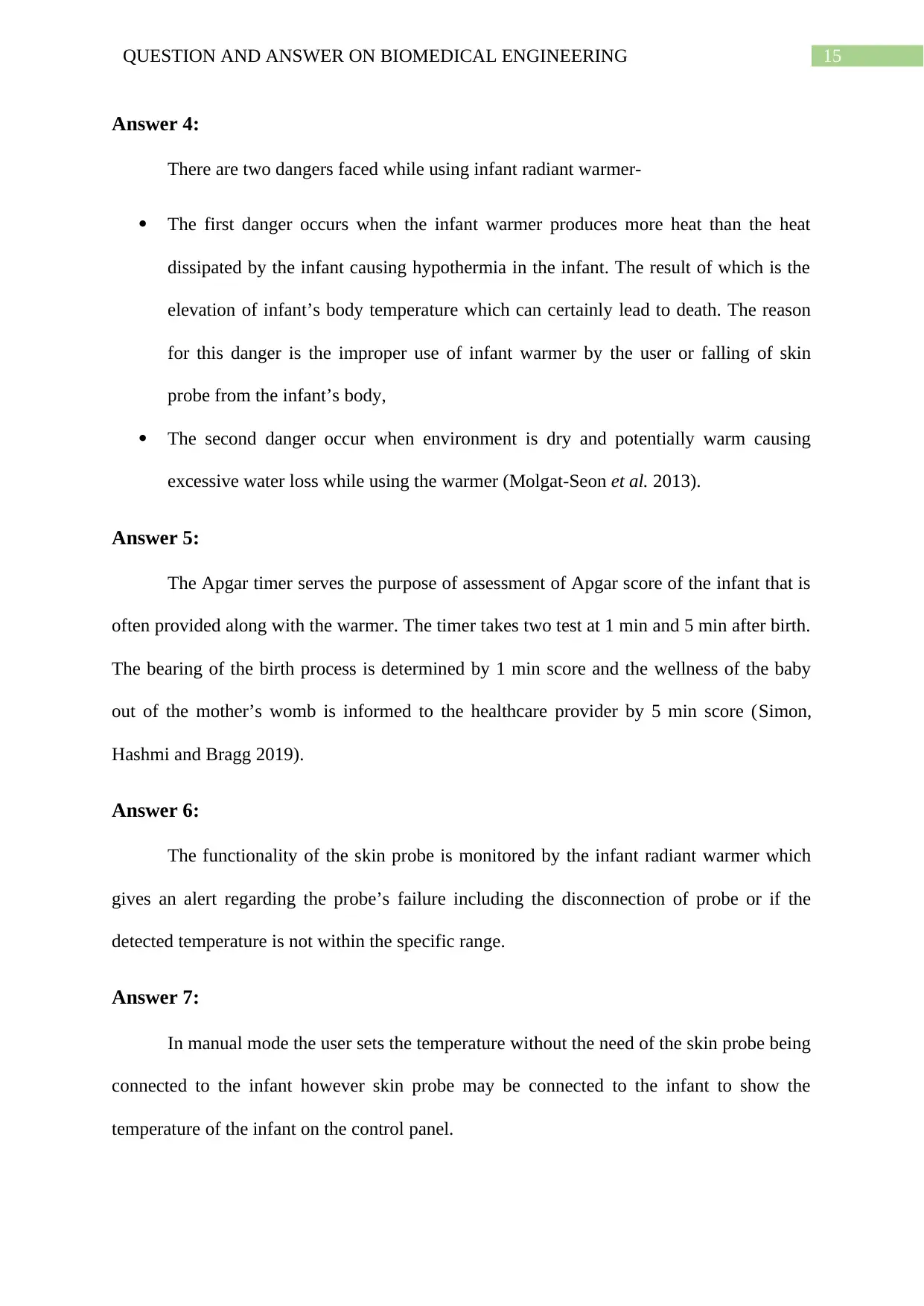
15QUESTION AND ANSWER ON BIOMEDICAL ENGINEERING
Answer 4:
There are two dangers faced while using infant radiant warmer-
The first danger occurs when the infant warmer produces more heat than the heat
dissipated by the infant causing hypothermia in the infant. The result of which is the
elevation of infant’s body temperature which can certainly lead to death. The reason
for this danger is the improper use of infant warmer by the user or falling of skin
probe from the infant’s body,
The second danger occur when environment is dry and potentially warm causing
excessive water loss while using the warmer (Molgat-Seon et al. 2013).
Answer 5:
The Apgar timer serves the purpose of assessment of Apgar score of the infant that is
often provided along with the warmer. The timer takes two test at 1 min and 5 min after birth.
The bearing of the birth process is determined by 1 min score and the wellness of the baby
out of the mother’s womb is informed to the healthcare provider by 5 min score (Simon,
Hashmi and Bragg 2019).
Answer 6:
The functionality of the skin probe is monitored by the infant radiant warmer which
gives an alert regarding the probe’s failure including the disconnection of probe or if the
detected temperature is not within the specific range.
Answer 7:
In manual mode the user sets the temperature without the need of the skin probe being
connected to the infant however skin probe may be connected to the infant to show the
temperature of the infant on the control panel.
Answer 4:
There are two dangers faced while using infant radiant warmer-
The first danger occurs when the infant warmer produces more heat than the heat
dissipated by the infant causing hypothermia in the infant. The result of which is the
elevation of infant’s body temperature which can certainly lead to death. The reason
for this danger is the improper use of infant warmer by the user or falling of skin
probe from the infant’s body,
The second danger occur when environment is dry and potentially warm causing
excessive water loss while using the warmer (Molgat-Seon et al. 2013).
Answer 5:
The Apgar timer serves the purpose of assessment of Apgar score of the infant that is
often provided along with the warmer. The timer takes two test at 1 min and 5 min after birth.
The bearing of the birth process is determined by 1 min score and the wellness of the baby
out of the mother’s womb is informed to the healthcare provider by 5 min score (Simon,
Hashmi and Bragg 2019).
Answer 6:
The functionality of the skin probe is monitored by the infant radiant warmer which
gives an alert regarding the probe’s failure including the disconnection of probe or if the
detected temperature is not within the specific range.
Answer 7:
In manual mode the user sets the temperature without the need of the skin probe being
connected to the infant however skin probe may be connected to the infant to show the
temperature of the infant on the control panel.
Secure Best Marks with AI Grader
Need help grading? Try our AI Grader for instant feedback on your assignments.
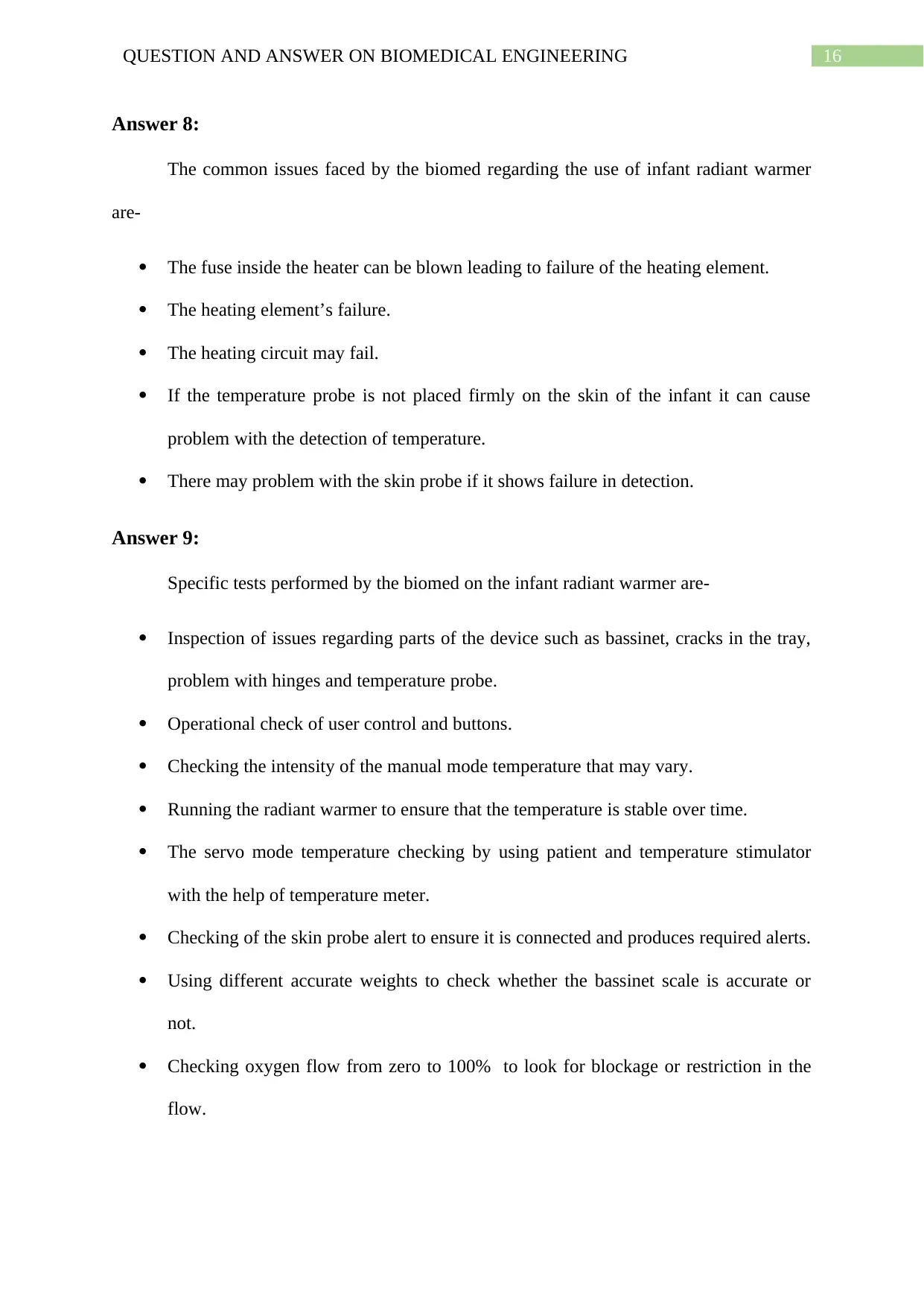
16QUESTION AND ANSWER ON BIOMEDICAL ENGINEERING
Answer 8:
The common issues faced by the biomed regarding the use of infant radiant warmer
are-
The fuse inside the heater can be blown leading to failure of the heating element.
The heating element’s failure.
The heating circuit may fail.
If the temperature probe is not placed firmly on the skin of the infant it can cause
problem with the detection of temperature.
There may problem with the skin probe if it shows failure in detection.
Answer 9:
Specific tests performed by the biomed on the infant radiant warmer are-
Inspection of issues regarding parts of the device such as bassinet, cracks in the tray,
problem with hinges and temperature probe.
Operational check of user control and buttons.
Checking the intensity of the manual mode temperature that may vary.
Running the radiant warmer to ensure that the temperature is stable over time.
The servo mode temperature checking by using patient and temperature stimulator
with the help of temperature meter.
Checking of the skin probe alert to ensure it is connected and produces required alerts.
Using different accurate weights to check whether the bassinet scale is accurate or
not.
Checking oxygen flow from zero to 100% to look for blockage or restriction in the
flow.
Answer 8:
The common issues faced by the biomed regarding the use of infant radiant warmer
are-
The fuse inside the heater can be blown leading to failure of the heating element.
The heating element’s failure.
The heating circuit may fail.
If the temperature probe is not placed firmly on the skin of the infant it can cause
problem with the detection of temperature.
There may problem with the skin probe if it shows failure in detection.
Answer 9:
Specific tests performed by the biomed on the infant radiant warmer are-
Inspection of issues regarding parts of the device such as bassinet, cracks in the tray,
problem with hinges and temperature probe.
Operational check of user control and buttons.
Checking the intensity of the manual mode temperature that may vary.
Running the radiant warmer to ensure that the temperature is stable over time.
The servo mode temperature checking by using patient and temperature stimulator
with the help of temperature meter.
Checking of the skin probe alert to ensure it is connected and produces required alerts.
Using different accurate weights to check whether the bassinet scale is accurate or
not.
Checking oxygen flow from zero to 100% to look for blockage or restriction in the
flow.

17QUESTION AND ANSWER ON BIOMEDICAL ENGINEERING
Testing the operation of the battery and replacing non-functional battery with new
one.
Documentation of all the tests and issues with the device (CBET 2018).
Testing the operation of the battery and replacing non-functional battery with new
one.
Documentation of all the tests and issues with the device (CBET 2018).
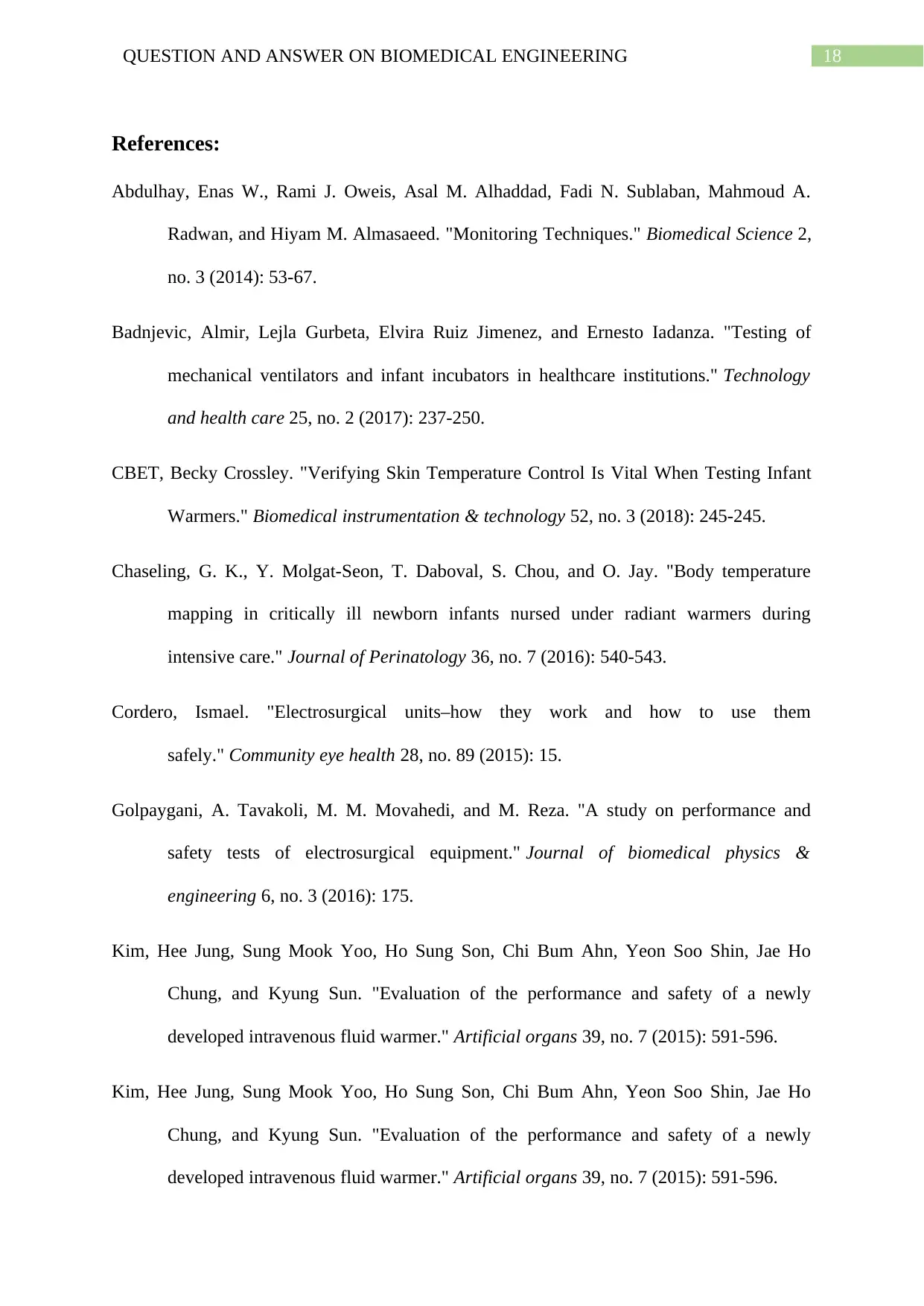
18QUESTION AND ANSWER ON BIOMEDICAL ENGINEERING
References:
Abdulhay, Enas W., Rami J. Oweis, Asal M. Alhaddad, Fadi N. Sublaban, Mahmoud A.
Radwan, and Hiyam M. Almasaeed. "Monitoring Techniques." Biomedical Science 2,
no. 3 (2014): 53-67.
Badnjevic, Almir, Lejla Gurbeta, Elvira Ruiz Jimenez, and Ernesto Iadanza. "Testing of
mechanical ventilators and infant incubators in healthcare institutions." Technology
and health care 25, no. 2 (2017): 237-250.
CBET, Becky Crossley. "Verifying Skin Temperature Control Is Vital When Testing Infant
Warmers." Biomedical instrumentation & technology 52, no. 3 (2018): 245-245.
Chaseling, G. K., Y. Molgat-Seon, T. Daboval, S. Chou, and O. Jay. "Body temperature
mapping in critically ill newborn infants nursed under radiant warmers during
intensive care." Journal of Perinatology 36, no. 7 (2016): 540-543.
Cordero, Ismael. "Electrosurgical units–how they work and how to use them
safely." Community eye health 28, no. 89 (2015): 15.
Golpaygani, A. Tavakoli, M. M. Movahedi, and M. Reza. "A study on performance and
safety tests of electrosurgical equipment." Journal of biomedical physics &
engineering 6, no. 3 (2016): 175.
Kim, Hee Jung, Sung Mook Yoo, Ho Sung Son, Chi Bum Ahn, Yeon Soo Shin, Jae Ho
Chung, and Kyung Sun. "Evaluation of the performance and safety of a newly
developed intravenous fluid warmer." Artificial organs 39, no. 7 (2015): 591-596.
Kim, Hee Jung, Sung Mook Yoo, Ho Sung Son, Chi Bum Ahn, Yeon Soo Shin, Jae Ho
Chung, and Kyung Sun. "Evaluation of the performance and safety of a newly
developed intravenous fluid warmer." Artificial organs 39, no. 7 (2015): 591-596.
References:
Abdulhay, Enas W., Rami J. Oweis, Asal M. Alhaddad, Fadi N. Sublaban, Mahmoud A.
Radwan, and Hiyam M. Almasaeed. "Monitoring Techniques." Biomedical Science 2,
no. 3 (2014): 53-67.
Badnjevic, Almir, Lejla Gurbeta, Elvira Ruiz Jimenez, and Ernesto Iadanza. "Testing of
mechanical ventilators and infant incubators in healthcare institutions." Technology
and health care 25, no. 2 (2017): 237-250.
CBET, Becky Crossley. "Verifying Skin Temperature Control Is Vital When Testing Infant
Warmers." Biomedical instrumentation & technology 52, no. 3 (2018): 245-245.
Chaseling, G. K., Y. Molgat-Seon, T. Daboval, S. Chou, and O. Jay. "Body temperature
mapping in critically ill newborn infants nursed under radiant warmers during
intensive care." Journal of Perinatology 36, no. 7 (2016): 540-543.
Cordero, Ismael. "Electrosurgical units–how they work and how to use them
safely." Community eye health 28, no. 89 (2015): 15.
Golpaygani, A. Tavakoli, M. M. Movahedi, and M. Reza. "A study on performance and
safety tests of electrosurgical equipment." Journal of biomedical physics &
engineering 6, no. 3 (2016): 175.
Kim, Hee Jung, Sung Mook Yoo, Ho Sung Son, Chi Bum Ahn, Yeon Soo Shin, Jae Ho
Chung, and Kyung Sun. "Evaluation of the performance and safety of a newly
developed intravenous fluid warmer." Artificial organs 39, no. 7 (2015): 591-596.
Kim, Hee Jung, Sung Mook Yoo, Ho Sung Son, Chi Bum Ahn, Yeon Soo Shin, Jae Ho
Chung, and Kyung Sun. "Evaluation of the performance and safety of a newly
developed intravenous fluid warmer." Artificial organs 39, no. 7 (2015): 591-596.
Paraphrase This Document
Need a fresh take? Get an instant paraphrase of this document with our AI Paraphraser
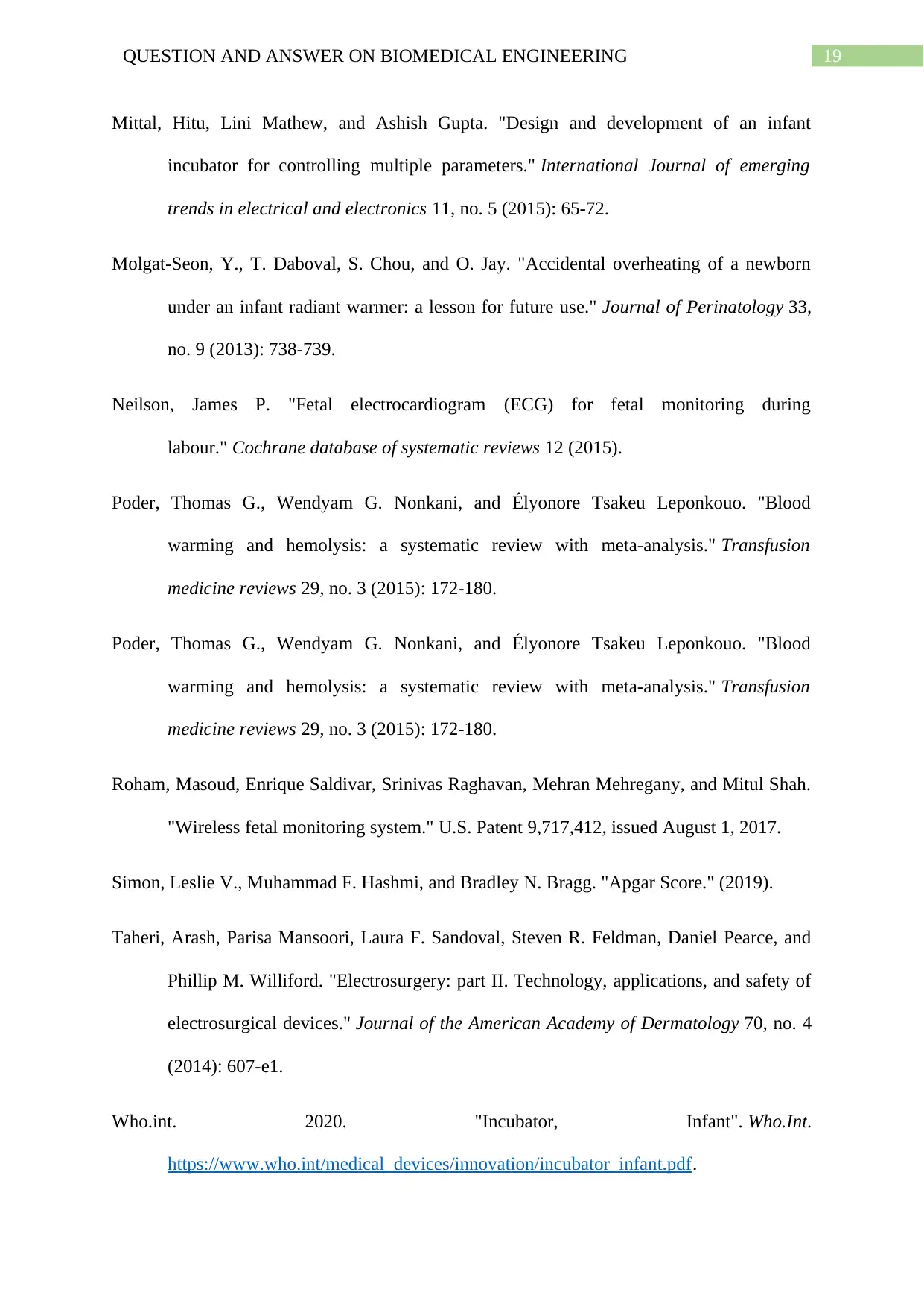
19QUESTION AND ANSWER ON BIOMEDICAL ENGINEERING
Mittal, Hitu, Lini Mathew, and Ashish Gupta. "Design and development of an infant
incubator for controlling multiple parameters." International Journal of emerging
trends in electrical and electronics 11, no. 5 (2015): 65-72.
Molgat-Seon, Y., T. Daboval, S. Chou, and O. Jay. "Accidental overheating of a newborn
under an infant radiant warmer: a lesson for future use." Journal of Perinatology 33,
no. 9 (2013): 738-739.
Neilson, James P. "Fetal electrocardiogram (ECG) for fetal monitoring during
labour." Cochrane database of systematic reviews 12 (2015).
Poder, Thomas G., Wendyam G. Nonkani, and Élyonore Tsakeu Leponkouo. "Blood
warming and hemolysis: a systematic review with meta-analysis." Transfusion
medicine reviews 29, no. 3 (2015): 172-180.
Poder, Thomas G., Wendyam G. Nonkani, and Élyonore Tsakeu Leponkouo. "Blood
warming and hemolysis: a systematic review with meta-analysis." Transfusion
medicine reviews 29, no. 3 (2015): 172-180.
Roham, Masoud, Enrique Saldivar, Srinivas Raghavan, Mehran Mehregany, and Mitul Shah.
"Wireless fetal monitoring system." U.S. Patent 9,717,412, issued August 1, 2017.
Simon, Leslie V., Muhammad F. Hashmi, and Bradley N. Bragg. "Apgar Score." (2019).
Taheri, Arash, Parisa Mansoori, Laura F. Sandoval, Steven R. Feldman, Daniel Pearce, and
Phillip M. Williford. "Electrosurgery: part II. Technology, applications, and safety of
electrosurgical devices." Journal of the American Academy of Dermatology 70, no. 4
(2014): 607-e1.
Who.int. 2020. "Incubator, Infant". Who.Int.
https://www.who.int/medical_devices/innovation/incubator_infant.pdf.
Mittal, Hitu, Lini Mathew, and Ashish Gupta. "Design and development of an infant
incubator for controlling multiple parameters." International Journal of emerging
trends in electrical and electronics 11, no. 5 (2015): 65-72.
Molgat-Seon, Y., T. Daboval, S. Chou, and O. Jay. "Accidental overheating of a newborn
under an infant radiant warmer: a lesson for future use." Journal of Perinatology 33,
no. 9 (2013): 738-739.
Neilson, James P. "Fetal electrocardiogram (ECG) for fetal monitoring during
labour." Cochrane database of systematic reviews 12 (2015).
Poder, Thomas G., Wendyam G. Nonkani, and Élyonore Tsakeu Leponkouo. "Blood
warming and hemolysis: a systematic review with meta-analysis." Transfusion
medicine reviews 29, no. 3 (2015): 172-180.
Poder, Thomas G., Wendyam G. Nonkani, and Élyonore Tsakeu Leponkouo. "Blood
warming and hemolysis: a systematic review with meta-analysis." Transfusion
medicine reviews 29, no. 3 (2015): 172-180.
Roham, Masoud, Enrique Saldivar, Srinivas Raghavan, Mehran Mehregany, and Mitul Shah.
"Wireless fetal monitoring system." U.S. Patent 9,717,412, issued August 1, 2017.
Simon, Leslie V., Muhammad F. Hashmi, and Bradley N. Bragg. "Apgar Score." (2019).
Taheri, Arash, Parisa Mansoori, Laura F. Sandoval, Steven R. Feldman, Daniel Pearce, and
Phillip M. Williford. "Electrosurgery: part II. Technology, applications, and safety of
electrosurgical devices." Journal of the American Academy of Dermatology 70, no. 4
(2014): 607-e1.
Who.int. 2020. "Incubator, Infant". Who.Int.
https://www.who.int/medical_devices/innovation/incubator_infant.pdf.

20QUESTION AND ANSWER ON BIOMEDICAL ENGINEERING
Who.int. 2020. "Infant Radiant Warmer". Who.Int.
https://www.who.int/medical_devices/innovation/compendium_med_dev2013_6.pdf.
World Health Organization, 2020. Fetal Monitoring. [online] Who.int. Available at:
<https://www.who.int/medical_devices/innovation/fetal_monitor.pdf> [Accessed 22
March 2020].
Who.int. 2020. "Infant Radiant Warmer". Who.Int.
https://www.who.int/medical_devices/innovation/compendium_med_dev2013_6.pdf.
World Health Organization, 2020. Fetal Monitoring. [online] Who.int. Available at:
<https://www.who.int/medical_devices/innovation/fetal_monitor.pdf> [Accessed 22
March 2020].
1 out of 21
Your All-in-One AI-Powered Toolkit for Academic Success.
+13062052269
info@desklib.com
Available 24*7 on WhatsApp / Email
![[object Object]](/_next/static/media/star-bottom.7253800d.svg)
Unlock your academic potential
© 2024 | Zucol Services PVT LTD | All rights reserved.

